Motorola Solutions 92FT5854 SPIRIT iDEN M710 User Manual M710 User Guide En indb
Motorola Solutions, Inc. SPIRIT iDEN M710 M710 User Guide En indb
Contents
- 1. USERS MANUAL
- 2. users manual
USERS MANUAL

Motorola
Digital Multi-service Data-capable Car Phone
M710 User's Guide

IMPORTANT NOTICE: PLEASE READ
PRIOR TO USING YOUR PHONE
The SIM card provided in this kit is intended for use with the phone
provided in this package.
Loss of certain features will result when using a SIM card from one of
the following models: i30sx, i35s, i50sx, i55sr, i58s, i60c, i80s, i85s, i88s,
i90c, i95cl series, and the i2000 series.
For more information on SIM card compatibility, go to www.
motorola.com/iden/support.
Defects or damage to your Motorola phone that result from the use
of non-Motorola branded or certified Accessories, including but not
limited to replacement housings and or other peripheral accessories,
are excluded from warranty coverage. Please refer to the text of
Motorola’s Limited One Year warranty located in this user’s guide for
complete details.

Dear customer,
Motorola M710 Fixed Mobile Car Phone is uniquely
designed for dedicated access to voice and data
communication from within the vehicle environment. With
its voice activation feature, enhanced display screen, well-
spaced keypad and all round hands-free environment, the
M710 is the more convenient way to talk and drive.
Key Product Features
• The M710 Voice Activated Dialing feature: Name dialing,
which allows you to speak a voice tag that you have
saved for a phonebook entry; and voice activated menu
access, which allows you to browse to frequently used
menu options by attaching voice tags to them.
• High quality hands-free operation enables you to
communicate in more convenient way while in the
vehicle environment.
• Enhanced color graphic display is designed for easy
reading using 8 mm character height, with an adjustable
backlight and contrast display setting.
• A well-spaced keypad with large, illuminated tactile keys
makes it easier for you to dial when mobile.
• Enjoy the luxury of installing a single fixed mount unit
that includes a display, keypad and radio, making the
installation process easier and faster.
• Value-added features including: Location Based Services
via integrated AGPS; “Push-To” Features including Push-To-
Talk, Push-To-Send Contacts and Push-To Send Pictures;
and Multimedia services for downloadable media
content
* Various phone features are network dependant.
** Specifications subject to change without prior notice.

Total Customer Satisfaction
Absolute customer satisfaction is Motorola’s top priority.
If you have a question, suggestion or any other issue
concerning the Motorola phone, Motorola wants to hear
from you.
Motorola Australia Customer Care:
1300138 823 8am - 6pm Australia EST
Motorola New Zealand Customer Care:
0508 668-676 10am - 8pm
Motorola Canada Customer Care:
1-800-461-4575
Motorola USA Customer Care:
866-289-6866
Software Copyright Notice
The Motorola products described in this manual, may
include copyrighted Motorola and third party software
stored in semiconductor memories or other media.
Laws in the United States and other countries preserve
for Motorola and third party software providers certain
exclusive rights for copyrighted software, such as the
exclusive rights to distribute or reproduce the copyrighted
software. Accordingly, any copyrighted software contained
in the Motorola products may not be modified, reverse-
engineered, distributed, or reproduced in any manner
to the extent allowed by law. Furthermore, the purchase
of the Motorola products shall not be deemed to grant
either directly or by implication, estoppel, or otherwise,
any license under the copyrights, patents, or patent
applications of Motorola or any third party software
provider, except for the normal, non-exclusive, royalty-free
license to use that arises by operation of law in the sale of
a product.
MOTOROLA, the Stylized M Logo and all other trademarks
indicated as such herein are trademarks of Motorola,Inc.®
Reg.U.S. Pat.&Tm.Off. TrueSync, Sidekick, Starfish and the
Stylized Starfish Logo are registered trademarks of Starfish
Software,Inc., a wholly owned independent subsidiary of
Motorola,Inc. All other product or service names are the
property of their respective owners.
©2006 Motorola,Inc. All rights reserved.

Safety Information
Important: Read this information before using your
wireless mobile phone.
Exposure to Radio Frequency Signal
our wireless mobile telephone is a low power radio
transmitter and receiver. When it is ON, it receives and also
sends out radio frequency (RF) signals.
Your Motorola wireless mobile telephone complies
with the following RF energy exposure standards and
guidelines:
• United States Federal Communications Commission,
Code of Federal Regulations; 47CFR part 2 sub-part J
• American National Standards Institute (ANSI) / Institute of
Electrical and Electronic Engineers (IEEE) C95. 1-1992
• Institute of Electrical and Electronic Engineers (IEEE)
C95.1-1999 Edition
• International Commission on Non-Ionizing Radiation
Protection (ICNIRP) 1998
• Ministry of Health (Canada) Safety Code 6. Limits of
Human Exposure to Radiofrequency Electromagnetic
Fields in the Frequency Range from 3 kHz to 300 GHz,
1999
• Australian Communications Authority
Radiocommunications (Electromagnetic Radiation
- Human Exposure) Standard, 2003
• ANATEL, Brazil Regulatory Authority, Resolution No. 303
of July 2, 2002 “Regulation of the limitation of exposure
to electrical, magnetic, and electromagnetic fields in the
radio frequency range between 9KHz and 300 GHz.” and
“Attachment to resolution # 303 from July 2, 2002”
The design of your phone complies with these standards
when used as described under "Phone Operation."
Antenna Installation Guidelines
Important: To meet the FCC's RF Exposure
guidelines and satisfy the categorical
exclusion requirements for mobile
transmitters, the antenna must be
installed so there is at least 30 cm of
separation between the antenna and
both the occupants of the vehicle and
bystanders outside of the vehicle.

Antenna Care
Use only the supplied or an approved replacement
antenna. Unauthorized antennas, modifications, or
attachments could damage the phone and may violate
local agency regulations.
Mobile Configuration
Do not operate your mobile telephone when a person is
within 12 inches (30 centimeters) of the antenna. A person
or object within 12 inches (30 centimeters) of the antenna
could impair call quality and may cause the phone to
operate at a higher power level than necessary and expose
that person to RF energy in excess of that established by
the FCC RF Exposure Guidelines.
Driving
Check the laws and regulations on the use of wireless
telephones in the areas where you drive. Always obey
them. Observe the following guidelines when using your
phone while driving.
• Give full attention to driving. Driving safely is your first
responsibility.
• Use hands-free phone operation, if available.
• Pull off the road and park before making or answering a
call if driving conditions so require.
Electronic Devices
Most modern electronic equipment is shielded from RF
signals. However, certain equipment may not be shielded
against the RF signals from your wireless phone.
Pacemakers
The Health Industry Manufacturers Association
recommends that a minimum separation of 6 inches
(15 centimeters) be maintained between a wireless
phone's antenna and a pacemaker to avoid potential
interference with the pacemaker. These recommendations
are consistent with the independent research by and
recommendations of Wireless Technology Research.
Persons with pacemakers:
• Should ALWAYS keep the phone more than 6 inches (15
centimeters) from their pacemaker when the phone is
turned ON
• Should turn the phone OFF immediately if you have any
reason to suspect that interference is taking place.

Other Medical Devices
If you use any other personal medical device, consult the
manufacturer of your device to determine if it is adequately
shielded from external RF energy. Your physician may be
able to assist you in obtaining this information.
Turn your phone OFF in health care facilities when any
regulations posted in these areas instruct you to do so.
Hospitals or health care facilities may be using equipment
that could be sensitive to external RF energy.
Vehicles
RF signals may affect improperly installed or inadequately
shielded electronic systems in motor vehicles. Check with
the manufacturer or its representative regarding your
vehicle. You should also consult the manufacturer of any
equipment that has been ad ded to your vehicle.
Posted Facilities
Turn your phone OFF in any facility where posted notices
so require.
Blasting Areas
To avoid interfering with blasting operations, turn your
phone OFF when in a "blasting area" or in areas posted:
"Turn off two-way radio." Obey all signs and instructions.
Potentially Explosive Atmospheres
Turn your phone OFF, do not remove your battery
when you are in any area with a potentially explosive
atmosphere, and obey all signs and instructions. Sparks
from your battery in such areas could cause an explosion or
fire resulting in bodily injury or e ven death.
Areas with a potentially explosive atmosphere are often but
not always clearly marked. They include: fueling areas such
as gasoline stations; below deck on boats; fuel or chemical
transfer or storage facilities; areas where fuel odors are
present (for ex ample, if a gas/propane leak occurs in a
car or home); areas where the air contains chemicals or
particles, such as grain, dust, or metal powders; and any
other area where you normally would be advised to turn
off your vehicle engine.
For Vehicles Equipped with an Air Bag
An air bag inflates with great force. Do NOT place objects,
including both installed or portable wireless equipment, in
the area over the air bag or in the air bag deployment area.
If in-vehicle wireless equipment is improperly installed and
the air bag inflates, serious injury could result.

FCC Grant of Equipment Authorization
FCC ID: AZ492FT5854
Canada Grant of Equipment Authorization
IC:109U-92FT5854
Network Freq Band Rated Power
iDEN 800/900MHz 0.354W
FCC INTERFERENCE
This device complies with Part 15 of the FCC Rules.
Operation is subject to the following two conditions:
(1) This device may not cause harmful interference.
(2) This device must accept any interference received,
including interference that may cause undesired operation.

i
Contents
Getting Started ......................................................1
Locating Your SIM Card ........................................................................2
Activating Service ...................................................................................2
Powering On and Off ............................................................................2
Enabling Over-the-Air Security .......................................................3
Finding Your Phone Number ...........................................................4
Phone Basics ...............................................................................................4
Entering Numbers From the Keypad ..........................................8
Setting the Ring Volume .....................................................................8
SIM Card Security .....................................................................................8
Accessories ...............................................................................................12
For More Information .........................................................................12
Making Calls ........................................................ 13
Phone Calls ...............................................................................................13
Private Calls ..............................................................................................13
Receiving Calls ....................................................................................... 13
Choosing a Number to Call ............................................................14
Missed Phone Calls .............................................................................. 16
Using Mute ............................................................................................... 16
Making Emergency Phone Calls .................................................16
Call Alerts ............................................................ 17
Sending Call Alerts ..............................................................................17
Receiving Call Alerts ...........................................................................17
Using the Call Alert Queue ............................................................. 18
Recent Calls ......................................................... 21
Calls and Call Alerts .............................................................................21
My Info From Other Phones ..........................................................21
Contact Information From Other Phones ............................. 22
Viewing the Recent Calls List ........................................................22
Storing Items to Contacts ............................................................... 23
Deleting Items ........................................................................................23
Making Calls From the Recent Calls List ................................. 24

ii
Contacts ............................................................... 25
Accessing Contacts ............................................................................. 26
Creating Entries ..................................................................................... 26
Storing Numbers Faster ....................................................................28
Editing Entries .........................................................................................29
Viewing Entries ......................................................................................29
Deleting Entries .....................................................................................31
Checking Capacity ............................................................................... 32
Creating Pauses and Waits .............................................................. 32
International Numbers ......................................................................33
Making Calls From Contacts .......................................................... 33
Accessing Contacts with GSM Phones ...................................34
Call Forwarding .................................................. 35
Turning Off Call Forwarding .......................................................... 36
Forwarding Missed Calls ..................................................................36
Viewing Call Forwarding Settings ..............................................37
Advanced Calling Features ................................ 39
Call Waiting ...............................................................................................39
Switching Between Calls .................................................................39
Putting a Call on Hold ........................................................................40
Calling 2 People .....................................................................................40
Duo Phones Service ............................................................................41
Creating Pauses and Waits While Dialing .............................. 41
Making International Calls ..............................................................41
Recording a Voice Message or a Call ........................................ 42
One Touch PTT .......................................................................................42
Quick PTT ...................................................................................................42
Call Timers .................................................................................................43
Using Your Phone as a Modem ...................................................44
Group Calls and Selective Dynamic Group
Calls ................................................................... 45
Group Calls ...............................................................................................45
Selective Dynamic Group (SDG) Calls .....................................47
Memo ................................................................... 53

iii
Contents
Ring Tones ........................................................... 55
Assigning Ring Tones to Contacts .............................................55
Viewing Ring Tone Assignments ................................................55
Downloading More Ring Tones ...................................................55
About DRM Ring Tones .....................................................................56
Managing Memory .............................................................................56
Deleting Custom Ring Tones ........................................................56
Entering Text ....................................................... 57
Using Word Mode ................................................................................57
Special Function Keys ........................................................................58
Messages ............................................................. 59
Message Notifications .......................................................................59
Message Center ..................................................................................... 60
Voice Mail Messages ........................................... 61
Receiving a Message ..........................................................................61
Accessing Voice Mail from the Message Center ...............61
Sending Unanswered Calls to Voice Mail ..............................61
MOSMS Messages ............................................... 63
Setting Up .................................................................................................63
Receiving a Message ..........................................................................64
Reading from the Message Center ............................................64
Creating and Sending Messages ................................................64
Sorting Messages .................................................................................67
Managing Memory .............................................................................67
Media Center ....................................................... 69
Viewing the Media Center .............................................................. 69
Forward Locked Items .......................................................................70
DRM Items ................................................................................................ 71
Pictures .......................................................................................................71
Audio Recordings ................................................................................. 72
Renaming Items ....................................................................................73
Locking Items ......................................................................................... 73
Deleting Items ........................................................................................74
Managing Memory .............................................................................74

iv
Digital Rights Management ............................... 77
Installing Items ....................................................................................... 77
Understanding DRM Status Icons ..............................................77
Sharing Items ..........................................................................................77
Managing DRM Items ........................................................................ 78
Using Send via PTT ............................................. 81
Sending a Picture ................................................................................. 81
Receiving a Picture ..............................................................................82
Sending My Info and Contact Information ..........................83
My Info ................................................................. 85
Viewing My Info .....................................................................................85
Editing My Info ....................................................................................... 85
Setting Sending Options .................................................................86
Datebook ............................................................. 87
Viewing Datebook ...............................................................................87
Creating Events ......................................................................................88
Editing Events ......................................................................................... 90
Deleting Events .....................................................................................91
Receiving Reminders ......................................................................... 91
Making Calls From Datebook and Datebook Reminders ..
92
Customizing Datebook Setup ...................................................... 93
Java Applications ................................................ 95
Installing Applications .......................................................................95
Running Applications ........................................................................ 95
Suspending Applications ................................................................96
Resuming Applications .....................................................................96
Ending Applications ........................................................................... 96
Downloading Applications ............................................................96
Deleting Applications ........................................................................ 97
Managing Memory .............................................................................97
Shortcuts on the Main Menu ........................................................98
Java Applications and GPS Enabled .........................................98
GPS Enabled ...................................................... 101
IMPORTANT: Things to Keep in Mind .................................... 101

v
Contents
Making an Emergency Call .......................................................... 102
Viewing Your Approximate Location .................................... 103
Enhancing GPS Performance ..................................................... 104
Updating Satellite Almanac Data ............................................ 105
Setting Privacy Options ................................................................. 105
Voice Records .................................................... 107
Viewing Voice Records ................................................................... 107
Creating Voice Records .................................................................. 108
Playing Voice Records ..................................................................... 108
Labeling Voice Records .................................................................. 108
Locking Voice Records ................................................................... 109
Deleting Voice Records .................................................................. 109
Managing Memory .......................................................................... 109
Customizing Your Phone .................................. 111
Setting the Volume .......................................................................... 111
Changing the Look of Your Phone ......................................... 111
Using Settings ..................................................................................... 112
Profiles ............................................................... 117
Editing Profiles ..................................................................................... 117
Setting Call Filtering ......................................................................... 117
Shortcuts ........................................................... 119
Creating a Shortcut .......................................................................... 119
Using a Shortcut ................................................................................ 119
Editing a Shortcut ............................................................................. 120
Deleting Shortcuts ............................................................................120
Optional Features ............................................. 121
Audio Routing ..................................................................................... 121
Muting Entertainment System ................................................. 122
Understanding Status Messages ..................... 123
Wireless Phone Safety Tips .............................. 125

vi
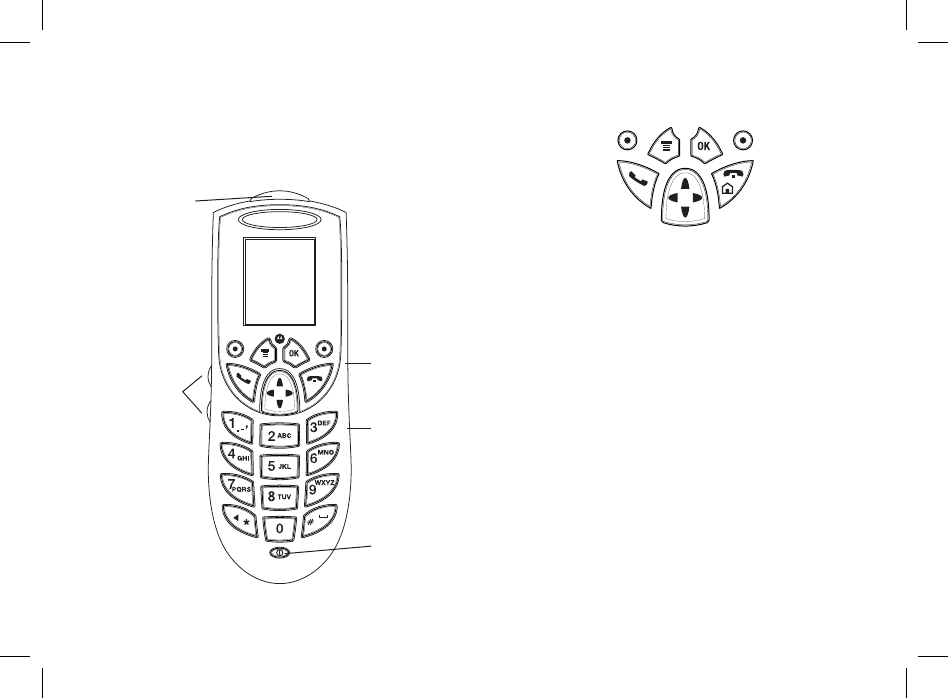
1
Getting Started
Volume
Controls
SIM Card
Housing
Power Button
Mini USB
Connector
Smart Key
NNavigation key – press the arrows to scroll
through menus and lists.
oOK key – selects highlighted item; answers
calls.
mMenu key – accesses context-sensitive
menus.
BOption key – selects the option appearing
above it on the display.
sSend key – places phone calls.
eEnd key – ends phone calls; returns to idle
screen.
.Smart Key – activates Voice Dial; end calls;
make PTT calls; starts recording a voice
message or the active call.
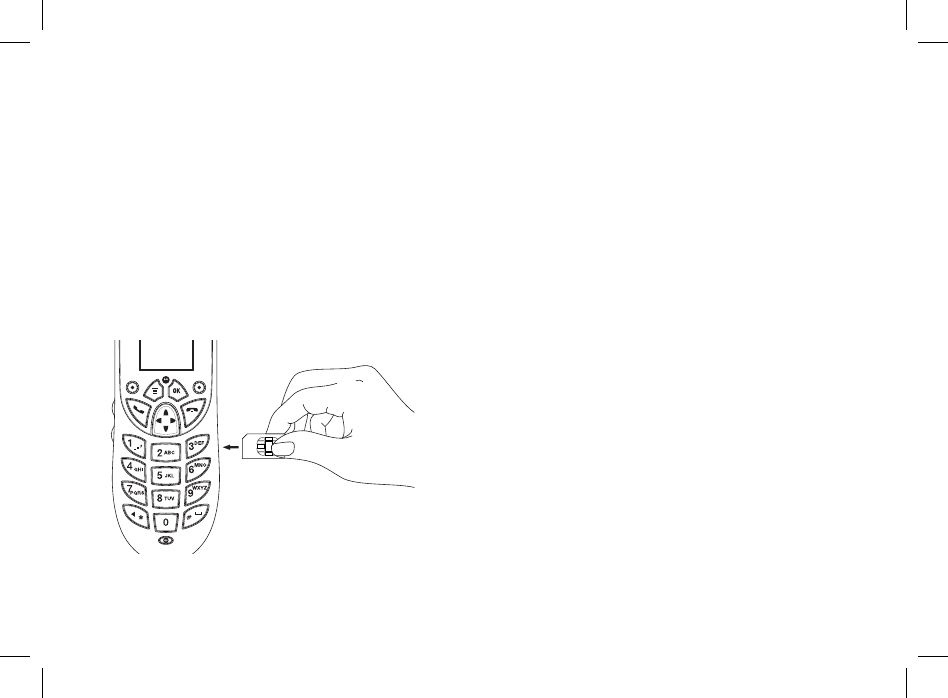
2
To start using your M710 phone:
• Make sure your SIM card is in place.
• Charge the battery.
• Activate your service.
• Enable over-the-air security if you are prompted to.
Locating Your SIM Card
Your SIM (Subscriber Identity Module) card is a small piece
of plastic located in the SIM card holder in the back of your
phone, underneath the battery.
If your SIM card is not in the SIM card holder, it may be in
the box your phone came in, attached to a piece of plastic
about the size of a credit card. If this is the case, carefully
detach your SIM card from the surrounding plastic and
insert it as described in “Inserting Your SIM Card” on page
12.
If there is no SIM card in your phone or the box, contact
your service provider.
Activating Service
The first time you power on your phone, you must be in
your local calling area. This activates your service.
Powering On and Off
The first time you power your phone on, a screen may
appear asking you to update your browser information.
This means you must enable security.
To power your phone on, Press p.
To power your phone off, Press and hold p.
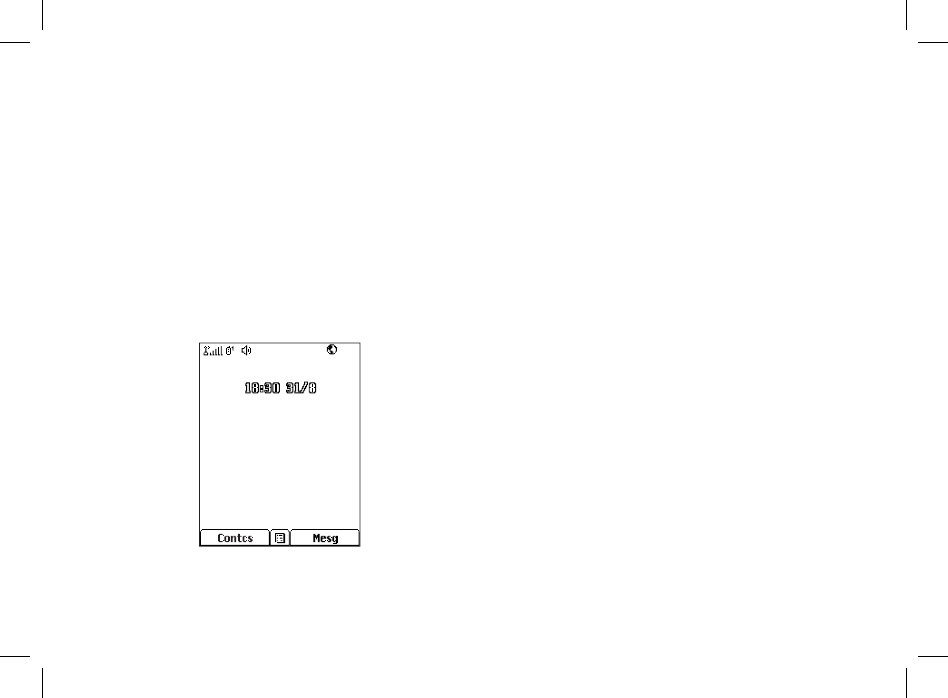
3
Getting Started
When You Power On For the First Time
If the Enter SIM PIN Code screen appears, enter your SIM
PIN. See “Entering the PIN” on page 9.
Press A under Ok.
When you receive your phone, the SIM PIN is 0000. Change
your PIN to prevent fraudulent use of the SIM card (see
“Changing the PIN” on page 13).
As your phone connects to the network, you will see a
welcome message and a connecting message. When the
idle screen appears, the phone is ready to use.
Ignition Sensor Powering
Your M710 phone powering is controled by an ignition
sensor, that will:
• Automatically power on the phone after the car was
started.
• When not in active call, power off the phone after the car
was tuned off.
• When turning the car off while in active call, to leave the
phone powered on, and powwer it off 6 seconds after
the call ended.
For more information, see in the phone's installation guide.
Enabling Over-the-Air Security
If you are set up to receive over-the-air programming from
your service provider, you must enable security the first
time you power on your phone or within 10 days of first
activation of your phone:
1 When you power on your phone for the first time, after
the idle screen appears, you will be prompted to select
Ok to update your browser information.

4
Note: If you press A under Later, you will be
prompted to enable security each time you
power on your phone until you press A under
Ok.
2 Press A under Ok.
3 You are prompted to enable security. Press A under
Yes. A series of screens appears. If you subscribe to your
service provider’s plan, your home page appears.
4 Press e to return to the idle screen.
Phone Programming
Within 24 hours of enabling security, you may receive an
alert notification containing your Private ID and Talkgroup
lists for Private calls.
To accept programming:
1 When you receive an alert notification saying New
Browser Message - Receive Programming Info,
press o or press A under Goto.
2 You are prompted to accept changes to your lists. Press
o or press A under Ok.
3 If you are prompted again to accept changes to your
lists, press o or press A under Ok.
4 A confirmation screen displays. Press o or press A
under Ok.
5 Press e to return to the idle screen.
Finding Your Phone Number
My Info lets you view your phone number, Private ID, and
other phone information:
1 Press m to access the main menu.
2 Scroll to My Info.
3 Press o.
4 Scroll to see your information.
Line 1 and Line 2 are your phone numbers. Private is
your Private ID, the number that others use to contact you
using Private service. These numbers appear when you
receive your alert notification after enabling security on
your phone. See “My Info” on page 99 for more information
about this feature.
Phone Basics
Any time your phone is powered on, the display provides
you with information and options.
The screen shown is the idle screen.
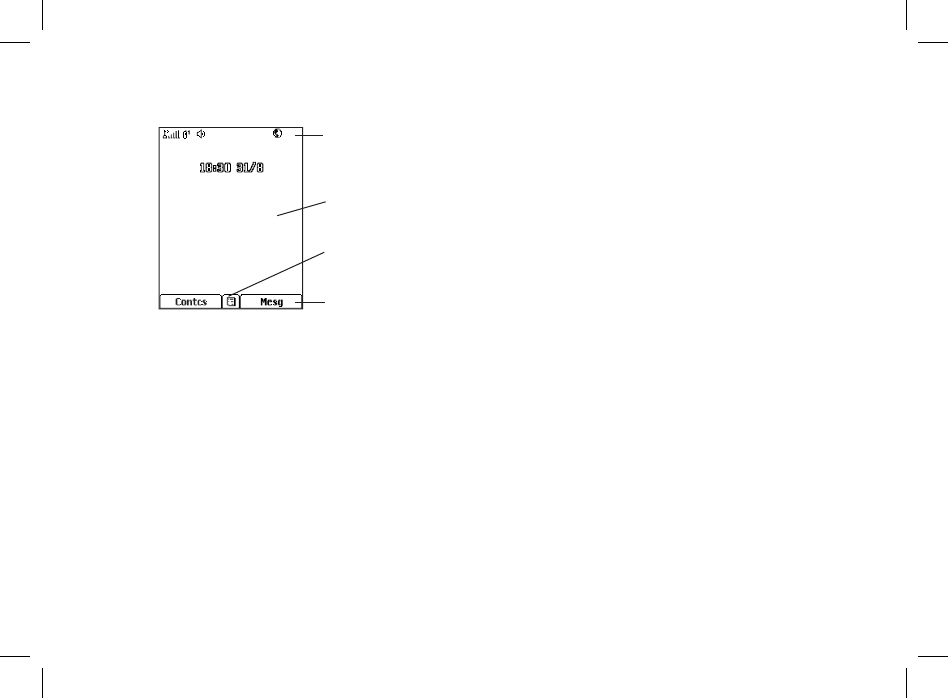
5
Getting Started
Display
options
Status icons
Menu icon
Text area
The text that appears on your idle screen depends on your
service provider. The idle screen appears when your phone
is on, but not engaged in any activity.
Text Area
This area displays menus, messages, names, phone
numbers, and other information.
Display Options
Two display options appear at the bottom of most screens.
You select a display option by pressing the option key A
below it.
Menus and Lists
Your phone’s features are arranged in menus, submenus,
and lists.
To access the items in a menu or list, scroll using the
navigation key at the top of your keypad. This key lets you
scroll up, down, left, or right. Holding down the appropriate
part of the navigation key speeds up scrolling.
In this guide, this symbol > tells you to select a menu or list
item. For example, Settings > Security means:
1 Scroll to Settings on the main menu.
2 Press o to see the Settings screen.
3 Scroll to Security.
4 Press o to see the Security screen.
OK Key
Pressing o:
• Selects the highlighted menu item or list item
• Sets options
• Confirms actions
• Places and answer calls

6
cVoiceRecord Record and play audio messages.
See page 121.
jMy Info View personal phone information,
including phone number and
Private ID. See page 99.
lGPS Find your approximate
geographical location. See page
115.
dContacts Create, view, store, edit Contacts
and SDG lists*. See page 31.
* Selective Dynamic Group Calling
(SDGC) may not be offered by your service
provider.
eMessages Access messages. See page 71.
fCall Forward Set call forwarding options. See
page 43.
oDatebook Schedule appointments. See
page101.
gMemo Store a number to access later. See
page 63.
Menu Key
Many features provide context-sensitive menus that let you
access related features and actions.
This icon S appears any time a context-sensitive menu is
available. Press m to access the menu.
Main Menu
All your phone’s features can be accessed through the
main menu. You can set the main menu to appear as a list
or as large icons.
aBrowser Browse the Web.
qJava Apps Java applications on your phone.
See page 109.
bSettings Customize your phone. See page
125.
mRing Tones Assign ring tones and turn ringer
off. See page 65.
*Media Center Access stored pictures and audio
recordings. See page 81.

7
Getting Started
hCall Timers Phone usage information. See
page 51.
iRecent Calls Lists recent calls. See page 25.
sShortcuts Create shortcuts to screens. See
page 133.
pProfiles Groups of settings you apply
together. See page 131.
kCall Alert Lists call alerts. See page 21.
QQuick PTT Access* any Private IDs and SDG
lists on your phone. See page 50.
* Quick PTT may not be offered by your
service provider.
Quick Access to Main Menu Items
Each arrow in the navigation key and o can be used to
access a main menu item from the idle screen. Each of
these keys is assigned to a main menu item when you
receive your phone. To assign different main menu items,
see “Personalize Features” on page 125.
Status Icons
Status icons appear at the top of the display. Some appear
at all times. Others appear only when your phone is
engaged in certain activities or when you have activated
certain features.
opqr
s
Signal Strength – More bars next to
the antenna indicate a stronger signal.
APhone In Use – Your phone is active on
a phone call.
BPrivate In Use – Your phone is active
on a Private call.
CTalkgroup In Use – Your phone is
active on a group call.
SSDG Call In Use– Your phone is active
on a SDG call.
2 1 Active Phone Line – 1 indicates phone
line 1 is ready to make calls; 2 indicates
phone line 2 is ready to make calls.

8
J G
K I
L H
Call Forward – Your phone is set to
forward calls. See page 43.
T x w
z y
Messages – You have one or more
messages. See page 71.
E D Internet – You are ready to browse the
internet.
cVoice Message – You recorded one or
more voice messages. See page 121.
Z Y Packet Data – You are ready to transfer
packet data or are transferring packet
data. See page 52.
Entering Numbers From the
Keypad
To enter numbers at the idle screen or any screen that
requires you to enter numbers, press the numbers on the
keypad.
If you make a mistake:
• To clear a digit, press A under Delete.
• To clear all digits, press and hold A under Delete.
• To insert or delete a digit anywhere in the string of
digits you have entered, scroll left or right.
• To cancel, press e.
Setting the Ring Volume
When not in a call, use the volume control buttons, located
at the left side of the phone, to set the phones ringing
volume.
To set the keypad sound level when you press any key:
1 Press m to access the main menu.
2 Select Settings > Volume > Keypad.
SIM Card Security
Your SIM card protects your personal information.
The SIM card stores all your Contacts information.
Since this information is stored on your SIM card, not in
your phone, you can remove the information by removing
your SIM card.

9
Getting Started
Note: Except for making emergency calls, your phone
will not function without the SIM card.
To prevent unauthorized use of your phone, your SIM card
may be protected by a PIN that you enter each time the
phone is powered on. You can change the PIN or turn off
the requirement that it be entered.
Entering the PIN
You may be required to enter a SIM PIN when you first use
your phone.
When you receive your phone, the SIM PIN is 0000. Change
your PIN to prevent fraudulent use of the SIM card.
Important: If you enter your PIN incorrectly 3 times,
your SIM card is blocked. To unblock your
SIM card, you must contact your service
provider. See “Unblocking the PIN” on
page 14.
1 When the Enter SIM PIN Code screen appears, enter
your SIM PIN. An asterisk appears for each character
entered.
2 Press A under Ok.
Changing the PIN
1 From the main menu, select Settings > Security >
Change Passwords > SIM PIN.
2 At the Enter Old SIM PIN screen, enter the current SIM
PIN.
3 Press A under Ok.
4 At the Enter New SIM PIN screen, enter the new 4- to
8-digit SIM PIN.
5 Press A under Ok.
6 At the Re-enter New SIM PIN screen, re-enter the
new SIM PIN to confirm.
7 Press A under Ok.
Turning the PIN Requirement On and Off
When the SIM PIN requirement is on, you are prompted to
enter your PIN each time you turn on your phone.
Note: If a SIM PIN is required, your phone will not
function until the SIM PIN is entered, except for
making emergency calls.
When the PIN requirement is off, your phone can be used
without entering a PIN.

10
To unblock the PIN:
1 Press *#m1.
2 At your service provider representative’s request,
provide the information needed to give you a PUK
code.
3 Select Unblock PIN.
4 Enter the PUK code.
5 Enter a new 4- to 8-digit SIM PIN.
6 Re-enter your SIM PIN.
If you entered the codes properly, SIM Unlocked appears
on the display.
Inserting and Removing Your SIM Card
Important: Do not touch the gold-colored areas of
your SIM card.
Switching SIM Cards
Moving your SIM card from one phone to another moves
all your Contacts information, but erases other information.
If you remove your SIM card and use it with another phone,
Important: When the SIM PIN requirement is off, the
personal data on your SIM card is not
protected. Anyone can use your phone
and access your personal data.
1 From the main menu, select Settings > Security >
SIM PIN.
2 Select On or Off.
3 Enter the current SIM PIN.
4 Press A under Ok.
Unblocking the PIN
If you enter your PIN incorrectly 3 times, your SIM card is
blocked. To unblock your SIM card, you must contact your
service provider to get a PIN Unblock Code (PUK).
Important: If you unsuccessfully enter the PUK code
10 times, your SIM card is permanently
blocked and must be replaced. If this
happens, all data is lost. You will get
a message to contact your service
provider. Except for making emergency
calls, your phone will not function with a
blocked SIM card.
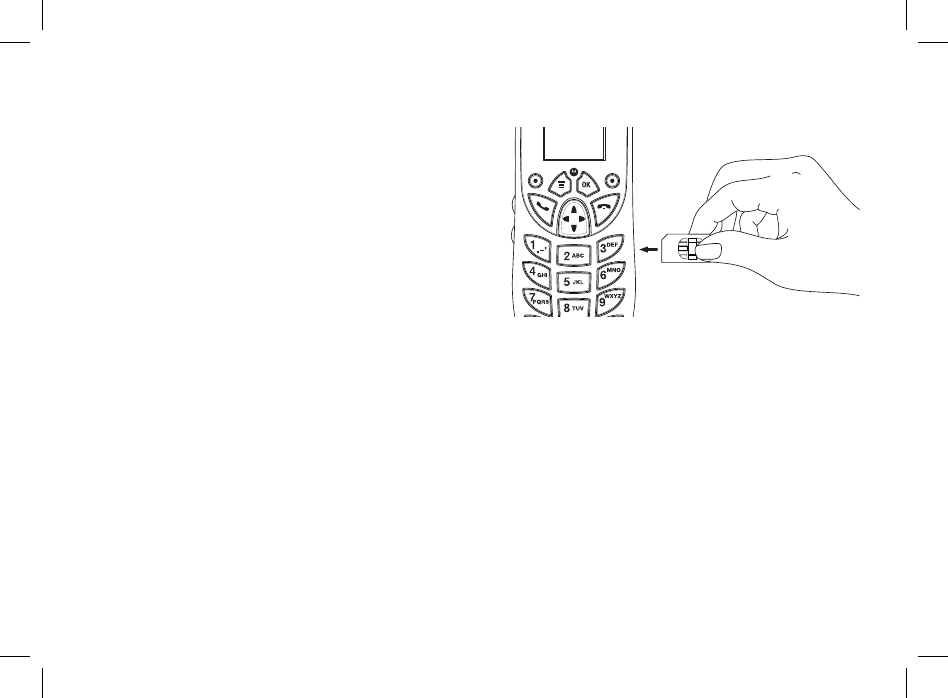
11
Getting Started
or use another SIM card with your phone, the following
information is erased:
• The recent calls list
• Call forwarding settings
• Net alerts
• MOSMS drafts, outbox messages, and customized quick
notes
• Information stored in Memo
• Pictures and audio recordings in the media center, except
those that are forward locked
• 3 most recent GPS Enabled locations
• Voice records
• Voice names
• Datebook events
• Options set using the Personalize menu
Inserting Your SIM Card
1 With your phone powered off, insert the SIM card into
the SIM card housing at the right side of the phone.
2 Press the SIM card into the housing, to make sure it
locks into place.
Removing Your SIM Card
Important: To avoid loss or damage, do not remove
your SIM card from your phone unless
absolutely necessary.
1 With your phone powered off, press on the SIM card
until you hear a release “click” sound.
2 Releave the presure from the SIM card, allowing it to
pop-out of the housing.
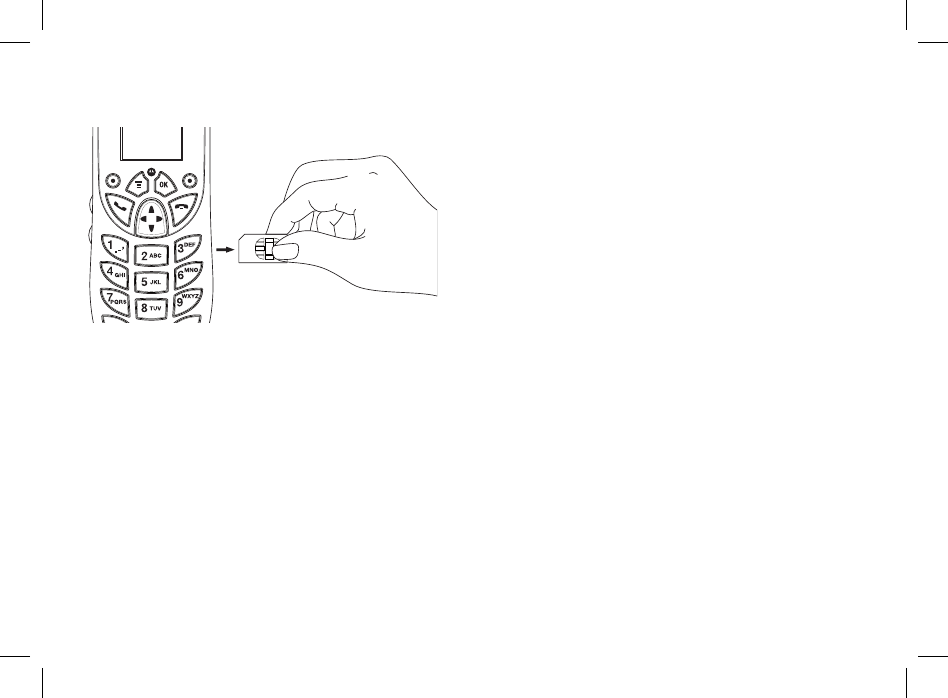
12
3 Remove the SIM card.
Note: Protect your SIM card as you would any
delicate object. Store it carefully.
Accessories
Your M710 phone comes with the following accessories:
Standard Accessories
• Microphone
• Speaker
• Mounting Cradle
• Octopus Cable
• Power Cable
• User Guide
• Installation Guide
• Getting Started Leaflet
Optional accessories
• External Privacy Handset
• Handheld Microphone
• Ptt Button
To order accessories, log on to our Web site at www.
motorola.com/store/iden or contact your Motorola
Authorized Retailer.
For More Information
If you have questions about your M710 phone,
contact your sales representative or your service
provider.

13
Making Calls
Your M710 phone makes two types of calls: digital cellular
phone calls and Private calls. With Privatecalls, you use your
phone as a long-range, digitalwalkie-talkie.
Phone Calls
1 Enter the number you want to call.
2 To place the call:
Press s. -or-
If you entered the number from the idle screen, press
o.
3 To end the call, press e.
Private Calls
1 Enter the Private ID you want to call.
2 Press and hold the external PTT install in your car, or
the Smart button . at the top of your phone. Begin
talking after your phone emits a chirping sound.
3 Release the PTT or Smart button to listen.
4 To end the call:
Press e. -or-
Press A under Exit.
A Private call ends automatically if there is no activity on
the call for a few seconds.
Tip: To let someone know you want to talk to him
or her on a Private call, send a call alert. See “Call
Alerts” on page 30.
Receiving Calls
Phone Calls
When you receive a phone call, your phone rings, vibrates,
or lights up its backlight.
Answering
Press s. -or-
Press o. -or-
Press A under Yes. -or-
Press any number key. -or-
Press the external PTT or the Smart button ..

14
To answer a call by pressing any number key, you must
have the Any Key Ans feature turned on (see “Phone Calls
Features” on page 126).
Sending to Voice Mail
Press e. -or-
Press A under No.
Ending
Press e. -or-
Press the external PTT or the Smart button ..
Private Calls
When you receive a Private call, your phone emits a
chirping sound or vibrates.
Answering
1 Wait for the caller to finish speaking.
2 Press and hold the external PTT install in your car, or
the Smart button . at the top of your phone. Begin
talking after your phone emits a chirping sound.
3 Release the PTT button to listen.
Ending
Press e. -or-
Press A under Exit. -or-
Press the external PTT or the Smart button ..
A Private call ends automatically if there is no activity on
the call for a few seconds.
Choosing a Number to Call
You can choose the number you want to call in many ways:
• Enter the number on the keypad. See “Entering Numbers
From the Keypad” on page 9.
• Say a voice name into your phone. See “Using a Voice
Name” on page 15.
• Use Speed Dial or Turbo Dial® to make a phone call. See
“Using Speed Dial and Turbo Dial®” on page 15.
• Redial the last phone number called. See “Redialing the
Last Number” on page 16.
• Select the number from the recent calls list. See “Making
Calls From the Recent Calls List” on page 26.
• Select the number from Contacts. See “Making Calls From
Contacts” on page 39.

15
Making Calls
• Select a number stored in Datebook. See “Making Calls
From Datebook and Datebook Reminders” on page 104.
• Use One Touch PTT to make a Private call. See “One Touch
PTT” on page 61.
• Use the number in Memo. See “Memo” on page 61.
• Select the number in a text message you have received.
See “Receiving a Message” on page 72.
Using a Voice Name
If you have created a voice name in Contacts for the
number you want to call, say the voice name into your
phone to enter the number. See page 32 for information
on voice names.
Note: Before using Voice Name to make a call, make
sure the idle screen is displayed.
You can use a voice name to enter a number with the flip
open or closed.
1 Press once on the external PTT or the Smart button
. at the top of your phone.
2 Speaking into the microphone, say the voice name
assigned to the number you want to call.
Your phone plays the name back to you.
3 If you are making a phone call, the call is placed
automatically.
Tip: To stop a phone call from being completed, press
the Smart button . or press e.
If you are making a Private call or a SDG call, press
and hold theexternal PTT button to place the call. For
information on how to enter Private ID, Group, or SDG,
See “Creating Entries” on page 30.
Using Speed Dial and Turbo Dial®
Each phone number stored in Contacts is assigned a Speed
Dial number, which you can use to call that number.
Speed Dial
1 From the idle screen, use the keypad to enter the
Speed Dial number assigned to the phone number you
want to call.
2 Press #.
3 Press ss.
Turbo Dial
From the idle screen, press and hold the Speed Dial
number (1 through 9) assigned to the phone number you
want to call.

16
Redialing the Last Number
Press and hold s to place a call to the last phone number
you called.
Missed Phone Calls
When you miss a call, this icon V and the number of
phone calls you have missed appear briefly.
If you want to dismiss the missed call message, press A
under Back. -or-
If you want to view the missed call on the recent calls
list, press A under View.
Using Mute
Muting calls lets you listen to incoming sound without
transmitting sound. Mute is available whenever you are on
an active call.
To turn mute on:
Press A under Mute.
While mute is on, Unmute appears as a display option.
To turn mute off:
Press A under Unmute.
Making Emergency Phone Calls
Your phone supports emergency calling. Emergency
phone calls can be made even when your SIM card is
blocked or not in your phone.
Dial 911 to be connected to an emergency response
center. If you are on an active call, you must end it before
calling 911.
When you make an emergency call, your phone’s GPS
Enabled feature can help emergency service personnel
find you, if you are in a location where your phone’s GPS
antenna has established a clear view of the open sky and
your local emergency response center has the equipment
to process location information. See “GPS Enabled” on page
110, and particularly “IMPORTANT: Things to Keep in Mind”
on page 110 and “Making an Emergency Call” on page 112,
for more information on the limitations of this feature.
Because of the limitations of this feature, always provide
your best knowledge of your location to the emergency
response center when you make an emergency call.
Important: Emergency calls cannot be placed while
the keypad is locked.
Important: If you have not registered on the
network, emergency calls cannot be
placed.

17
Call Alerts
Sending a call alert lets the recipient know you want to talk
to him or her on a Private call.
When you send a call alert, the recipient’s phone emits
a series of beeps, or vibrates, and displays your name or
Private ID.
The recipient can:
• Answer – begin a Private call with the sender
• Queue – store the call alert to the call alert queue, which
is a list of call alerts
• Clear – dismiss and delete the call alert
Sending Call Alerts
1 Enter the Private ID you want to send to, as you would
when making a Private call.
2 Press A under Alert. Ready to Alert appears on the
display.
3 Press the external PTT button until Alert Successful
appears on the display.
Note: If the alert is not successful, the person you are
trying to reach is on a call or has the phone
turned off.
Receiving Call Alerts
When you receive a call alert, you must answer, queue, or
clear it. You cannot receive phone calls or Private calls until
you do.
To answer a call alert:
Press the external PTT button to make a Private call to
the sender.
To queue a call alert:
Press A under Queue.
To clear a call alert:
Press o. -or-
Press A under Clear.
Note: The recent calls list also stores call alerts you
have received. They appear as Private calls. Call
alerts remain in your recent calls list until you
delete them or until they reach the end of the
list.

18
Using the Call Alert Queue
When you queue a call alert, it remains in the call alert
queue until you make a Private call to the sender or delete
it.
Viewing Call Alerts
1 From the main menu, select Call Alert.
2 Scroll through the list.
Viewing Date and Time
To view the date and time a call alert was received:
1 From the main menu, select Call Alert.
2 Select the call alert you want information on.
3 Press o to dispaly the call alert details.
Responding to Call Alerts in the Queue
After you queue a call alert, you can respond to it by
making a Private call to the sender or sending a call alert to
the sender.
Making a Private Call to the Sender
1 From the main menu, select Call Alert.
2 Scroll to the call alert you want to respond to.
3 Press the extrnal PTT button to begin the call.
This removes the call alert from the queue.
Sending a Call Alert to the Sender
1 From the main menu, select Call Alert.
2 Scroll to the call alert you want to respond to.
3 Press A under Alert. Ready to Alert appears on the
display.
4 Press the external PTT button until Alert Successful
appears on the display.
Deleting Call Alerts
To delete a call alert from the queue:
1 From the call alert queue, scroll to the call alert you
want to delete.
2 Press m.
3 Select Delete.
4 Press o or press A under Yes to confirm.

19
Call Alerts
To delete all call alerts from the queue:
1 From the call alert queue, press m.
2 From the call alert menu, select Delete All.
3 Press o or press A under Yes to confirm.
Sorting Call Alerts
Tip: You must have at least one call alert in the queue
to access this feature.
To sort call alerts by the order they were received:
1 From the main menu, select Call Alert.
2 Press m.
3 Select Sort By.
4 Select First on Top or Last on Top.

20

21
Recent Calls
The recent calls list displays information associated with
calls you have made and received and call alerts you have
received. It also displays My Info and contact information
sent to you from other phones.
The recent calls list displays up to 20 items.
Calls and Call Alerts
The recent calls list contains the numbers of up to 20 of the
most recent calls you have made and received.
If the number of a recent call is stored in Contacts, the
following information appears:
• The name assigned to the number
• The picture assigned to the number, if your phone is set
to show pictures on the recent calls list. See “Choosing
Picture View or List View” on page 34. Pictures appear for
phone calls only.
• The Contacts type icon associated with the number. If
the Contacts entry containing the number has more
than one number or address stored, <> surrounds the
Contacts type icon. For information on Contacts types,
see page 37.
The Private ID Contacts type icon appears when you
receive a Private call or call alert, even if the number is not
stored in Contacts.
Call alerts you have received appear as Private calls. Like
all items in the recent calls list, they remain listed until you
delete them or until they reach the end of the list.
For phone calls, an additional icon appears giving
information about the call:
X A call you made.
W A call you received.
V A missed call. Missed calls appear on the recent calls
list only if you have Caller ID.
When you select a call to view its details, you see
information such as the name associated with the call, the
number, date, time, and duration of the call.
My Info From Other Phones
Note: This feature may not be offered by your service
provider.
The recent calls list displays My Info from other phones. See
“Sending My Info and Contact Information” on page 93.

22
This icon j appears with My Info from other phones on
the recent calls list, along with the Private ID of the person
who sent the information.
When you select My Info from other phones to view its
details, you see all the information sent.
If you receive My Info from the same phone more than
once, only the most recently sent version appears in the
recent calls list.
Contact Information From Other
Phones
Note: This feature may not be offered by your service
provider.
The recent calls list displays contact information sent from
other phones. This information comes from the other
phone’s Contacts list or recent calls list. See “Sending My
Info and Contact Information” on page 93.
This icon d appears with contact information on the
recent calls list.
Contact information in the recent calls list displays:
• The name contained in the contact information
• The Contacts type icon associated with the number or
address contained in the contact information. If the item
contains more than one number or address stored, <>
surrounds the Contacts type icon.
The name or Private ID of the person who sent the contact
information appears as a separate item on the recent calls
list, above the information sent. If one person sends you
more than one item of contact information, all the items
appear below the person’s name or Private ID.
When you select contact information to view its details,
you see the name or Private ID of the person who sent the
information and all the information in the item.
If you receive contact information with the same name
from the same phone more than once, only the most
recently sent version appears in the recent calls list.
Viewing the Recent Calls List
1 From the main menu, select Recent Calls.
2 Scroll through the list.
To view the details of an item on the list:
From the recent calls list, select the item you want
information on.

23
Recent Calls
Tip: To view the details of more items, keep scrolling.
Choosing Picture View or List View
You can set your phone to show the picture associated
with each item as you view the recent calls list or show the
list without pictures.
1 From the recent calls list, press m.
2 Select Recent Calls View.
3 Select List View to show the recent calls list without
pictures. -or-
Select Picture View to show the picture associated
with each entry.
Storing Items to Contacts
1 From the recent calls list, scroll to or select the item you
want to store.
2 Press A under Store. -or-
If Store is not one of your options: Press m. Select
Store or Update Contacts.
Tip: If the item you want to store is a call, Store does
not appear if the number is already stored in
Contacts.
3 To store the item as a new entry, select [New Contact].
-or-
To store the number to an existing entry, select the
entry.
Note: Storing My Info or contact information from
another phone to a Contacts entry that has a
name assigned to it does not change the name
of the Contacts entry.
4 If the item you want to store is a call, you must assign a
Contacts type to the number:
With the Contacts type field highlighted, scroll left or
right to display the Contacts type you want to assign
the number.
5 If you want to add more information to the entry, follow
the applicable instructions in “Creating Entries” on page
38.
6 Press A under Save.
Deleting Items
To delete an item from the recent calls list:
1 From the recent calls list, scroll to or select the item you
want to delete.

24
2 Press A under Delete. -or-
If Delete is not one of your options: Press m. Select
Delete.
3 Press o or press A under Yes to confirm.
To delete all items on the recent calls list:
1 From the recent calls list, press m.
2 Select Delete All.
3 Press o or press A under Yes to confirm.
Making Calls From the Recent Calls
List
1 From the main menu, select Recent Calls.
2 Scroll to the item containing the number you want to
call.
• If you scroll to a call, you can make a call to the
number that made the call. If the number is stored in
Contacts, you can make a call to any of the numbers
stored with it.
• If you scroll to My Info from another phone, you can
make a call to the Private ID of the phone that sent
the information.
• If you scroll to contact information from another
phone, you can make a call to any of the numbers in
the contact information.
3 To place the call now, go to step 4. -or-
Scroll left or right to display the Contacts type for the
number you want to call.
4 To make a phone call, press s. -or-
To make a Private call, press the external PTT button.
You can also make calls while viewing the details of an item
on the recent calls list:
1 From the recent calls list, select the item containing the
number you want to call.
• If you select a call or contact information from
another phone, you can make a call to the number
shown first on the details screen.
• If you scroll to My Info from another phone, you can
make a call to the Private ID of the phone that sent
the information.
2 To make a phone call, press s. -or-
To make a Private call, press the external PTT button.

25
Contacts
Contacts stores up to 600 numbers or addresses. Each
Contacts entry can store several numbers or addresses.
Information stored in Contacts is saved on your SIM card.
A Contacts entry contains:
• A name – A name is required if you are storing more
than one number or address to the entry; otherwise, it is
optional. Typically, this is the name of the person whose
contact information is stored in the entry.
• A ring tone – This is the sound your phone makes when
you receive phone calls or call alerts from any of the
numbers stored in the entry. You can assign the ring
tone from your list of ring tones. If you do not assign a
ring tone, the entry is created with a default ring tone
assigned.
• A picture – This picture appears on the display when
you receive phone calls from any of the phone numbers
stored in the entry. You can assign the picture from the
pictures stored in the media center. If you do not assign a
picture, the entry is created with no picture assigned.
• A Contacts type – Each number or address stored must
be assigned a Contacts type:
AMobile phone number
BPrivate Private ID
CWork1 phone number
DWork2 phone number
EHome phone number
FEmail email address
GFax phone number
HPager phone number
ITalkgroup Talkgroup number
SSDG SDG list* number
* Selective Dynamic Group Calling
(SDGC) may not be offered by your
service provider.
JIP IP address
KOther phone number

26
• A number or address – Each Contacts entry must contain
a number or address. This may be any type of phone
number, Private ID, SDG list number, Talkgroup number,
email address, or IP address.
Note: You can store numbers up to 64 digits long, but
every 20 digits must be separated by a pause
or wait. See “Creating Pauses and Waits” on
page 44.
• A Speed Dial number – When you store a phone number,
it is assigned a Speed Dial number. You can accept the
default Speed Dial number or change it.
• A voice name – If you create a voice name for a number,
you can then dial that number by saying the voice name
into your phone. This icon P appears to the left of the
Contacts type icon if a voice name is assigned.
Accessing Contacts
From the main menu, select Contacts. -or-
If you are on a call: Press m. Select Contacts.
Creating Entries
A number or address and a Contacts type are required for
all Contacts entries. Other information is optional. You may
enter the information in any order by scrolling through the
entry details.
After you have entered the number or address, Contacts
type, and any other information you want, you can press
A under Save to save the entry to Contacts. To cancel a
Contacts entry at any time, press e to return to the idle
screen.
To create a Contacts entry:
1 To access the entry details screen: Select Contacts >
[New Contact]. -or-
From the Contacts list, press m. Select New Contact.
2 If you want to assign a name to the entry: Select Name.
Enter the name. See “Entering Text” on page 70. When
you are finished, press o.
Tip: Press A under Browse to select a name already in
Contacts.
3 If you want to assign a ring tone or picture to the entry,
select [Ring Tone/Picture]. See “Assigning a Ring Tone
or Picture”.

27
Contacts
4 To assign a Contacts type to the number or address
being stored:
Select the Contacts type field.
Select the Contacts type you want to assign.
Note: For information about creating SDG lists, see
“Creating SDG Lists in Contacts” on page 61.
5 To store a number or address:
Select the # field (or ID for an email address, or IP for an
IP address).
Enter the number or address. For phone numbers, use
the 10-digit format. For email addresses, see “Entering
Text” on page 70.
Tip: Press A under Browse to select a number or
address from Contacts, the recent calls list, or
Memo.
When you are finished, press o.
6 If you want to change the default Speed Dial number
or a create a voice name for the entry, select [Options].
See “Assigning a Speed Dial Number or Voice Name” on
page 40.
7 If you want to add more numbers or addresses to the
entry:
Scroll past the information you already entered.
Enter the additional information for the entry using
step 3 through step 6. You must assign a name to the
entry, if you have not already.
8 Press A under Save.
Assigning a Ring Tone or Picture
1 If you have not already, select [Ring Tone/Picture].
2 If you want to assign a ring tone from the list of ring
tones:
With Ringer highlighted, scroll left or right to choose a
ring tone. -or-
Select Ringer. Select the ring tone you want to assign.
3 If you want to assign a picture from the media center:
Scroll to Picture. Scroll left or right to choose a picture.
-or-
Select Picture. Select the picture you want to assign.
Only pictures that can be assigned to Contacts entries are
displayed. Some large pictures cannot be assigned.

28
Tip: If an entry has a picture assigned and you want
the entry to have no picture, select [No Picture]
or press A under Unassign.
4 When you are finished, press A under Back.
Assigning a Speed Dial Number or Voice
Name
1 If you have not already, select [Options].
2 The default Speed Dial number assigned to a phone
number is displayed in the Speed # field. This is always
the next available Speed Dial location.
If you want to assign the phone number to a different
Speed Dial location:
With the Speed # field highlighted, press o.
Press A under Delete to delete the current Speed Dial
number.
Enter the new Speed Dial number using the keypad.
When you are finished, press o.
3 If you want to create a voice name for a phone number,
select Voice Name.
As directed by the screen prompts, say and repeat the
name you want to assign to the number. Speak clearly
into the microphone.
4 When you are finished, press A under Back.
Storing Numbers Faster
To store numbers to Contacts from the recent calls list, see
“Storing Items to Contacts” on page 34.
To store numbers to Contacts from Memo, see “Memo” on
page 66.
To store numbers to Contacts from the idle screen:
1 Use the keypad to enter the number you want to store.
2 Press m.
3 Select Store Number.
4 To store the number as a new entry, select [New
Contact]. -or-
To store the number to an existing entry, select the
entry.
5 With the Contacts type field highlighted, scroll left or
right to display the Contacts type you want to assign
the number.

29
Contacts
6 If you want to add more information to the entry, follow
the applicable instructions in “Creating Entries” on page
38.
7 Press A under Done.
Editing Entries
1 From the Contacts list, scroll to or select the entry you
want to edit.
2 Press A under Edit. -or-
If Edit is not one of your options:
Press�m. Select Edit.
The entry details screen displays.
3 Follow the applicable instructions in “Creating Entries”
on page 38 to edit the various fields.
Viewing Entries
When you view Contacts entries, you can choose how
much detail you want to see.
Viewing the Contacts List
In this view, each entry shows:
• The name assigned to the entry
• A small version of the picture assigned to the entry, if you
have set Contacts to show pictures in the Contacts list.
See “Choosing Picture View or List View” on page 42.
• The types of numbers and addresses stored in the entry
To view entries from the Contacts list:
1 Access Contacts.
2 Scroll to view entries.
Tip: To find Contacts entries faster, use the keypad to
enter the first letter of the name.
3 If an entry has more than one number or address
stored, <> surrounds the Contacts type icon. Scroll left
or right to view the icon for each number stored in the
entry.
Selecting an Entry
In this view, each entry shows:
• The name assigned to the entry
• A small version of the picture assigned to the entry

30
• The name of the ring tone assigned to the entry
• The numbers and addresses stored in the entry
To select an entry:
1 From the Contacts list, select the entry you want to
view.
2 Scroll to view the numbers and addresses stored in the
entry.
Tip: To select other entries: Scroll left or right. Or, press
# or *.
To return to the Contacts list, press A under Back.
Viewing More Details
When an entry is selected, you can view more details about
the entry by selecting items within the entry.
Viewing Details of a Number or Address
1 Select the entry.
2 Select the number or address you want to view details
of.
If you select a phone number, you can view its Speed
Dial number and see whether it has a voice name.
To return to the entry, press A under Back or press o.
Viewing a Large Picture
To view a large version of the picture assigned to an entry:
1 Select the entry.
2 Select the first item shown on the entry screen. This
item shows the name assigned to the entry or No
Name.
Note: You cannot make calls from this view.
To return to the entry, press A under Back or press o.
Choosing Picture View or List View
You can set Contacts to show the picture assigned to each
entry as you view the Contacts list or show the Contacts list
without pictures.
1 From the Contacts list, press m.
2 Select Contacts View.
3 Select List View to show the Contacts list without
pictures. -or-
Select Picture View to show the picture assigned to
each entry.

31
Contacts
Searching for a Name
To search for a name in Contacts:
1 From the Contacts list, press A under Search. -or-
If Search is not one of your options: Press m. Select
Search.
2 Enter the name you want to see. See “Entering Text” on
page 70.
3 Press o.
Your phone finds the name you entered or the nearest
match.
Showing Only Private IDs, SDG Lists, and
Talkgroups
To set Contacts to show only entries that contain Private
IDs, SDG lists, and Talkgroup entries:
1 From the Contacts list, press m.
2 Select Filter.
3 Set this option to Show Prvt/Grp.
To set Contacts to show all entries:
1 From the Contacts list, press m.
2 Select Filter.
3 Set this option to Show All.
Deleting Entries
Delete an Entry
1 From the Contacts list, scroll to or select the entry you
want to delete.
2 Press m.
3 To delete the entire entry, select Delete Contact or
Delete SDG List.
4 Press o or press A under Yes to confirm.
Delete a Number or Address
1 From the Contacts list, scroll to the entry that contains
the number or address you want to delete.
2 Scroll left or right to display the Contacts type for the
number you want to delete. -or-
Select the entry. Scroll to or select the number you
want to delete.
3 Press m.

32
4 Select Delete Number.
5 Press o or press A under Yes to confirm.
Note: If an entry contains only one number or
address, deleting the number or address
deletes the entry.
Checking Capacity
To see how many numbers are stored in Contacts:
1 From the Contacts list, press m.
2 Select Capacity.
Creating Pauses and Waits
When storing a number, you can program your phone to
pause or wait between digits while dialing. A pause makes
your phone pause for 3 seconds before dialing further.
A wait makes your phone wait for your response before
dialing further.
This feature is useful when using voice mail or other
automated phone systems that require you to dial a phone
number and then enter an access number.
To program a pause:
Press and hold * until the letter P appears. The P
represents a 3-second pause.
If you store 17035551235P1234, when you select this
number and make a call, your phone dials the first 11 digits,
pauses for 3 seconds, then dials the last 4 digits.
If you want a pause longer than 3 seconds, press and hold *
more than once. Each P represents a 3-second pause.
To program a wait:
Press and hold * until the letter W appears. The W
means your phone waits before dialing further.
If you store 17035551235W1234, when you select this
number and make a call, your phone dials the first 11 digits
and then waits. A message appears asking if you want to
send the rest of the digits. Press A under Yes to dial the last
4 digits.
Tip: You can create pauses and waits while dialing a
number from the keypad. See “Creating Pauses
and Waits While Dialing” on page 52.

33
Contacts
International Numbers
Note: This feature may not be offered by your service
provider.
When storing a number that you plan to use for
international calls, use Plus Dialing:
1 Press and hold 0 for two seconds. A “0” appears, then
changes to a “+”.
Note: The network translates the “+” into the
appropriate international access code needed
to place the call.
2 Enter the country code, city code or area code, and
phone number.
For information about making international calls, see
“Making International Calls” on page 52.
Making Calls From Contacts
While Viewing the Contacts List
1 Access Contacts.
2 Scroll to the name or number you want to call.
Tip: To find Contacts entries faster, use the keypad to
enter the first letter of the name.
3 To place the call now, go to step 4. -or-
Scroll left or right to display the Contacts type for the
number you want to call.
4 To make a phone call, press s. -or-
To make a Private call, press the PTT button.
If you are making a Private call, your phone places the call
to the Private ID stored in the Contacts entry, even if the
Private icon is not displayed.
If you are making a phone call:
• Your phone places the call to the phone number
assigned to the Contacts type displayed.
• If the Contacts type displayed is not a phone number,
your phone places the call to the phone number stored
in the Contacts entry.
• If the Contacts type displayed is not a phone number
and you have more than one phone number stored in
the Contacts entry, your phone prompts you to select the
phone number you want to place the call to.

34
After Selecting an Entry
1 Access Contacts.
2 Select the Contacts entry that contains the number you
want to call.
3 Scroll to or select number you want to call.
4 To make a phone call, press s. -or-
To make a Private call, press the PTT button.
If you try to make a type of call that does not match the
Contacts type of the number you chose, no call is placed.
Accessing Contacts with GSM
Phones
If you plan to use the information stored in Contacts with
an i2000, i2000plus, or any other GSM phone, download
iDEN Phonebook Manager.
Go to idenphones.motorola.com/iden/support for more
information.
You can use iDEN Phonebook Manager to make the
Contacts information saved to your M710 phone’s SIM card
accessible in this type of phone.

35
Call Forwarding
Call forwarding sends calls to the phone numbers you
specify. You can forward all calls to one number or forward
missed calls to different numbers depending on the reason
you missed the call.
You can forward phone lines 1 and 2 independently.
Forwarding All Calls
When you set your phone to forward all calls, an icon
appears in the top row of the display:
GPhone line 1 is active; calls to phone line 1 are
being forwarded.
HPhone line 1 is active; calls to phone line 2 are
being forwarded.
IPhone line 1 is active; calls to phone lines 1 and 2
are being forwarded.
JPhone line 2 is active; calls to phone line 1 are
being forwarded.
LPhone line 2 is active; calls to phone line 2 are
being forwarded.
KPhone line 2 is active; calls to phone lines 1 and 2
are being forwarded.
To forward all calls:
1 From the main menu, select Call Forward > Forward
> All Calls.
2 Select To.
If you specified a forwarding number for all calls before,
this number displays.
To forward calls to this number, press A under Back.
To delete this number, press o, then press and hold A
under Delete.
3 To enter the number you want to forward calls to: Enter
the number using your keypad. -or-
Press A under Search. Select Contacts, Recent Calls,
or Memo. Select the number you want to enter.
4 Press o.
All your calls are now forwarded to the number you
specified.

36
Turning Off Call Forwarding
If you do not want all your calls forwarded, turn the
feature off:
1 From the main menu, select Call Forward > To.
2 Set this option to Off.
All your calls are now sent to your phone.
Calls you miss are forwarded according to the options set
for missed calls. By default, missed calls are forwarded to
voice mail.
Note: To receive voice mail messages, you must first
set up a voice mail account with your service
provider.
Forwarding Missed Calls
You can specify a forwarding number for each type of
missed call:
• If Busy – Your phone is on a call or transferring data.
• If No Answer – You do not answer on the first 4 rings.
• If Unreachable – Your phone is out of coverage or
powered off.
Note: If you want a type of missed call sent to voice
mail, the call forwarding number for that type
of missed call must be your voice mail access
number.
To forward missed calls:
1 From the main menu, select Call Forward > Forward
> Detailed.
2 Select If Busy to specify a forwarding number for calls
received when your phone is busy.
3 If you specified a forwarding number for this type of call
before, this number displays.
To forward calls to this number, press B under Back
and go to step 6. -or-
To delete this number, press o, then press and hold A
under Delete.
4 To enter the number you want to forward this type of
call to:
Enter the number using your keypad. -or-
Press A under Search. Select Contacts, Recent Calls,
or Memo. Select the number you want to enter.
5 Press o.

37
Call Forwarding
6 Repeat step 2 through step 5 for If No Answer and If
Unreachable.
7 When you are finished, press A under Back.
Viewing Call Forwarding Settings
1 From the main menu, select Call Forward > Forward
> All Calls.
2 With To highlighted, press A under Status.

38

39
Advanced Calling Features
Call Waiting
Call Waiting lets you receive a second call while on an
active call. Call Waiting is always available, unless you turn it
off for a specific call.
If you are on a call and receive a second call, your phone
emits a tone and displays a message saying you are
receiving a second call.
To accept the second call and put the active call on hold:
Press A under Yes.
To accept the second call and end the active call:
1 Press e.
Your phone rings with the second call.
2 Answer the second call.
To decline the second call:
Press A under No. If you subscribe to voice mail, the call
is forwarded to your voice mail box, unless you set Call
Forward for If Busy to a different number.
Turn Off Call Waiting
To turn off Call Waiting during a call:
1 Press m.
2 Select In Call Setup > Call Waiting.
3 Set this option to Off.
Tip: To turn Call Waiting back on while still on the call,
set this option to On.
To turn off Call Waiting for the next call you make or
receive:
1 From the main menu, select Settings > Phone Calls >
Call Waiting.
2 Set this option to Off.
Call Waiting is turned back on when you end the call.
Switching Between Calls
Any time you have one call active and one call on hold,
to make the call on hold active and put the active call on
hold:
Press A under Switch. -or-
If Switch is not one of your options: Press m. Select
Switch.

40
To make the call on hold active and put the active call on
hold:
Press A under Switch.
Merging 2 Calls into a 3-Way Call
After you put a call on hold and place a second call, you
can combine these calls into a 3-way call:
1 Press m.
2 Select Join.
All 3 people in the call can speak to and hear each other.
Making a 3-Way Call
1 Place or receive a phone call.
2 While the call is active, press m.
3 Select 3 Way. This puts the call on hold.
4 Enter the second phone number you want to call.
Tip: For quick ways to enter the number, press m.
5 Press s to place the call.
6 Press A under Join.
All 3 people in the call can speak to and hear each other.
Putting a Call on Hold
1 While on an active call, press m.
2 Select Hold.
If you want to make the call active again, press A under
Resume.
Calling 2 People
Putting a Call on Hold, Making a Second
Call
1 Place or receive a phone call.
2 While the call is active, press m.
3 Select 2nd Call. This puts the call on hold.
4 Enter the second phone number you want to call.
Tip: For quick ways to enter the number, press m.
5 Press s to place the call.
To end the second call and make the call on hold active
again:
Press e.

41
Advanced Calling Features
Duo Phones Service
Note: This service is subjected to subscription with
your service provider.
The duo phones service is based on the installation of the
M710 car phone in addition to your mobile cellular phone,
both connected to the same service provider, and using
the same subscripion.
When you recieve a call, both phones will ring up to 6
times. Answering the call with either of them, will cause the
other phone to stop ringing.
If the call was not answered by both phones, it will be
transfered to the VoiceMail of the mobile phone.
Creating Pauses and Waits While
Dialing
You can enter a pause or wait while dialing a number.
For information on using pauses and waits, see “Creating
Pauses and Waits” on page 44.
To create a pause while dialing a phone number:
1 From the keypad, enter the digits you want to occur
before the pause.
2 Press m.
3 Select Insert Pause.
4 Enter the digits you want to occur after the pause.
To create a wait while dialing a phone number:
1 From the keypad, enter the digits you want to occur
before the wait.
2 Press m.
3 Select Insert Wait.
4 Enter the digits you want to occur after the wait.
Making International Calls
Note: This feature may not be offered by your service
provider.
Plus Dialing lets you place an international call to most
countries without entering the local international access
code.
1 Press and hold 0 for two seconds. A “0” appears, then
changes to a “+”.
Note: The network translates the “+” into the
appropriate international access code needed
to place the call.

42
2 Enter the country code, city code or area code, and
phone number.
Recording a Voice Message or a
Call
Your M710 phone can record a Voice Message or a phone
call.
To start recording a message or a call:
Press anfd hold the external PTT or Smart button for 2
seconds.
One Touch PTT
One Touch PTT sets your phone to call the most recent
Private ID or SDG list on the recent calls list, or a Private ID
you choose, every time you press the PTT button.
Setting One Touch PTT
To the Most Recent Private ID or SDG List
1 From the main menu, select Settings > 2-Way Radio
> One Touch PTT.
2 Set this option to Last Call.
To A Private ID
1 From the main menu, select Settings > 2-Way Radio
> One Touch PTT > Assigned Number.
2 To enter the Private ID you want your phone to call
every time you press the PTT button:
Enter the number using your keypad. -or-
Press A under Search. Select Contacts, Recent Calls,
or Memo. Select the number you want to enter.
Tip: If you are entering a Talkgroup number, enter #
before the number.
3 Press o.
Turning Off One Touch PTT
1 From the main menu, select Settings > 2-Way Radio
> One Touch PTT.
2 Set this option to Off.
Quick PTT
Note: This feature may not be offered by your service
provider.
Quick PTT lets you quickly access any Private IDs on your
phone so that you can make a Private call, or create a SDG

43
Advanced Calling Features
list and make a SDG call. For more information about SDG
lists, see “Selective Dynamic Group (SDG) Calls” on page 61.
To view a list of Contacts and SDG lists with Private IDs in
Contacts:
1 From the idle screen, press m.
2 Select Quick PTT.
To move between Contacts, the recent calls list, and Memo:
Scroll left or right. -or-
Press * or #.
To make a Private call or SDG call:
1 Select the entries you want.
2 Press A under Done.
3 Press the external PTT button or the Smart button at
the top of your phone.
To save your selections as a SDG list:
1 Press m.
2 Select Store SDG.
3 If you want to assign a name to the SDG list, enter the
name.
Note: If you do not assign a name, the SDG list is
named “SDG” followed by the number of
members in the SDG list. For example, “SDG (8)”
for a SDG list with 8 members.
4 Press o.
Call Timers
Call timers measure the duration of your phone calls,
Private or group calls, and circuit data use, as well as the
number of Kilobytes sent and received by your phone:
• Last Call – displays the duration of your most recent
phone call.
• Phone Reset – keeps a running total of your phone call
minutes, until you reset it.
• Phone Lifetime – displays the total minutes of all your
phone calls.
• Prvt/Grp Reset – keeps a running total of all of your
Private and group call minutes, until you reset it.
• Prvt/Grp Lifetime – displays the total minutes of all
your Private and group calls.
• Circuit Reset – keeps a running total of all of your circuit
data use, until you reset it.

44
• Circuit Lifetime – displays the total minutes of all of
your circuit data use.
• Kbytes Reset – keeps a running total of the number
of Kilobytes sent and received by your phone, until you
reset it.
To view or reset a timer:
1 From the main menu, select Call Timers.
2 Select the feature you want to view or reset.
3 To view a feature without resetting: Press o when you
are finished viewing. -or-
To reset a feature: Press A under Reset. Press o or
press A under Yes to confirm.
Note: The values displayed by Call Timers should not
be used for billing. Call timers are estimates
only.
Using Your Phone as a Modem
Note: This feature may not be offered by your service
provider.
To use your phone as a modem with a laptop, handheld
device, or desktop computer:
1 Connect the Mini-USB connector of the data cable to
the Mini-USB port at the right side of the phone.
2 Insert the USB data plug into the data port of the other
device.
When used as a modem, your phone has these data
transfer modes:
• Circuit data – used for sending and receiving faxes and
for transferring large files
• Packet data – used for small file transfers such as email
To use these services, you must install the iDEN Wireless
Data Services software (available separately). For more
information on setting up your computer and your M710
phone for packet and circuit data calls, refer to the Wireless
Data Services User’s Guide or contact your service provider.

45
Group Calls and Selective
Dynamic Group Calls
Note: Selective Dynamic Group Calling (SDGC) may
not be offered by your service provider.
Your phone gives you 2 ways to call more than one Private
ID at once:
• Group calls – calls to a Talkgroup
• Selective Dynamic Group calls – calls to a SDG list
Note: In order to store SDG lists to your M710, you
must use a SDG-capable SIM card. For more
information about SDG-capable SIM cards,
contact your service provider. SDG lists created
with your M710 phone are not readable by an
older iDEN SIM-based phone.
Calls Group SDG
Set-up Predefined, via your
service provider
administrator using
Group Management
Dynamically, via your
phone
Group
Names
Talkgroups ISDG lists S
Voice
Activated
Dialing
No Yes
Group Calls
A group call is similar to a Private call, but is made to
all members of a Talkgroup at once. A Talkgroup is a
predetermined group of your service provider’s customers.
Before you can make or receive group calls, a Talkgroup
must be established. After the Talkgroup is established, you
must join the Talkgroup.
Joining a Talkgroup
Your sales representative or your service provider
establishes Talkgroups for you and assigns each Talkgroup a

46
Turning off Group Calls
To set your phone to prevent you from hearing group calls
to your Talkgroup:
1 From the main menu, select Settings > 2-Way Radio
> Tkgrp Silent.
2 Set this option On.
To set your phone to let you hear group calls to your
Talkgroup:
Set Tkgrp Silent to Off in step 2.
Talkgroup number. You can choose a name for each of your
Talkgroups when you create entries for them in Contacts.
To receive group calls made to any of these Talkgroups, you
must join the Talkgroup.
1 From the main menu, select Contacts.
2 Scroll to the Talkgroup you want to join.
3 Press A under Join.
Note: You can only monitor one Talkgroup at a time.
Making Group Calls
1 Press #. Then enter the Talkgroup number using the
keypad. -or-
Choose the Talkgroup name from Contacts or recent
calls list.
2 Proceed as if making a Private call.
Receiving Group Calls
To answer a group call:
Proceed as if answering a Private call. Only one person
at a time may speak on a group call. The Private ID or
name of the person who is speaking will appear on the
display below the Talkgroup number.

47
Group Calls and Selective Dynamic Group Calls
Selective Dynamic Group (SDG)
Calls
Note: This feature may not be offered by your service
provider.
A SDG call is similar to a Private call, but is made to all
members of a SDG list at once. A SDG list is a group of
Private IDs that you create using your phone. A SDG list
must contain at least 2 members and can contain up to 20
members.
You can create a SDG list for one call only or store it to
Contacts so you can call it any time.
You can use Send via PTT* to send SDG lists to other
phones that have this capability.
* Send via PTT may not be offered by your service provider.
Creating SDG Lists in Contacts
1 From the main menu, select Contacts.
2 Select [New SDG List].
Note: You can also create a SDG list by selecting
[New Contact] and assigning the SDG contact
type.
3 If you want to assign a name to the SDG list, enter the
name.
Note: If you do not assign a name, the SDG list is
named “SDG” followed by the number of
members in the SDG list. For example, “SDG (8)”
for a SDG list with 8 members.
4 Add Private IDs. See “Adding Private Numbers”.
5 If you want to create a voice name for the SDG list,
select [Options] > Voice Name. As directed by the
screen prompts, say and repeat the voice name you
want to assign to the SDG list. Speak clearly into the
microphone.
6 Press A under Save.
Adding Private Numbers
You can add Private IDs to a SDG list by selecting them
from Contacts, the recent calls list, or Memo. You can add
all members in an existing SDG list by selecting the list.
You can select more than one member from Contacts
and the recent calls list. A checkmark appears next to each
selected item.
Tip: To deselect an item: Scroll to a selected item and
press o.

48
You can also enter Private IDs from the keypad.
To add members from Contacts, the recent calls list, or
Memo:
1 While creating a SDG list, select [Add Member]. -or-
2 Select [Add Number] and press A under Browse.
Note: To move between Contacts, the recent calls list,
and Memo, scroll left or right, or press * or
#.
3 Scroll to the members you want from Contacts, the
recent calls list, or Memo and press o. A checkmark
appears next to each selected member.
Note: To deselect a member, scroll to a selected
member and press o.
4 Press A under Done.
To add members manually from the keypad:
1 While creating a SDG list, select [Add Number].
2 Enter the Private number using the keypad.
3 Press o.
Removing Members or SDG Lists
To remove a member from a SDG list:
1 From Contacts, scroll to the SDG list you want to delete
the member from.
2 Press A under Edit.
3 Scroll to the member you want to remove.
4 Press m.
5 Select Remove Member.
6 Select Save.
To remove all members from a SDG list:
1 From Contacts, scroll to the SDG list you want to delete
the member from.
2 Press A under Edit.
3 Press m.
4 Select Remove All Members.
5 Press A under Yes.
To delete a SDG list from Contacts:
1 Scroll to the SDG list you want to delete.
2 Press m.

49
Group Calls and Selective Dynamic Group Calls
3 Select Delete SDG List.
Storing SDG Lists Faster
From the Recent Calls List
1 From the recent calls list, select the SDG list you want.
2 Press A under Store.
3 If you want, add more information to the entry.
4 Press A under Save.
From an Active SDG Call
1 During an active SDG call, press m.
2 Select Store SDG.
3 If you want, add more information to the entry.
Note: You cannot record a voice name during an
active call.
4 Press A under Save.
Making SDG Calls
1 From Contacts or the recent calls list, scroll to or select
the SDG list you want. -or-
Press and hold the external PTT or the Smart button
. until a prompt appears telling you to say the
voice name. Say the voice name assigned to the SDG
list you want. -or-
From the idle screen, press the number on your keypad
for the shortcut you assigned to the SDG list you want.
-or-
Enter or select a Private ID and add more Private IDs.
See “Starting a SDG Call with a Private ID”.
2 Press the PTT button.
Starting a SDG Call with a Private ID
You can start a SDG call with any Private ID you want to call.
1 Choose the first Private ID that you want in the SDG call:
From the idle screen, enter the Private ID. -or-
From the Contacts list, scroll to an entry containing the
Private ID. -or-
From recent calls list, scroll to an entry containing the
Private ID.
2 Press m.
3 Select Call New SDG.

50
4 Add more Private IDs. See “Adding Private Numbers” on
page 61.
5 If you want to save the SDG list you have created: Press
m. Select Store SDG. -or-
If you do not want to save the SDG list, press A under
Done.
6 To make the call, press the external PTT or the Smart
button.
Receiving SDG Calls
To answer a SDG call:
Proceed as if answering a Private call. Only one person
at a time may speak on a SDG call.
SDG Call Information
While you are in a SDG call, the following appears on the
screen:
• The name of the SDG list
• The name or the Private ID of the person speaking
• The number of participants in the SDG call
SDG Call Details
During a SDG call, you can view details about the other
SDG list members, such as their name or Private ID, and
their status on the call.
To view SDG call details, press A under Details.
In the SDG Call Details view, these icons appear next to
member names or Private IDs:
TThe member of the SDG list who is speaking.
AA member of the SDG list who is active on the SDG
call, but not speaking.
OA member of the SDG list who has exited the call.
UA member of the SDG list who could not be reached
on the SDG call.
uA member of the SDG list whose status is unknown.
Sending SDG Lists Using Send via PTT
Note: Send via PTT may not be offered by your
service provider.
You can send a SDG list using Send via PTT so that the
person who receives the SDG list can use the list.

51
Group Calls and Selective Dynamic Group Calls
1 From Contacts or the recent calls list, scroll to or select
the SDG list you want. -or-
From the idle screen, press the number on your keypad
for the shortcut you assigned to the SDG list you want.
2 Press m.
3 Select Send SDG via PTT.
4 To include yourself in the list, press A under Yes. -or-
To exclude yourself from the list, press A under No.
Note: If you choose to include yourself and the
list already contains 20 members, you will
be prompted that the list is full. You will be
excluded from the list.
5 Enter the Private ID of the person you want to send the
SDG list to. -or-
Select Browse to select a contact from Contacts, the
recent calls list, or Memo.
6 Press o.
7 To send the SDG list, push the PTT button.
The SDG list will display in the recent calls list on the
phone that you send the SDG list to.

52

53
Memo
Memo lets you store a number, make a call to that number,
and save it to Contacts.
To create a memo:
1 From the main menu, select Memo.
2 Enter the number using your keypad.
3 Press o.
To view the memo later:
From the main menu, select Memo.
To delete the memo:
1 From the main menu, select Memo.
2 Press and hold A under Delete.
3 Press o.
To edit the memo:
1 From the main menu, select Memo.
2 Enter the new number.
3 Press o.
To make a call to the memo number:
1 From the main menu, select Memo.
2 To make a phone call, press s. -or-
To make a Private call, press the external PTT or Smart
button.
To store the memo number to Contacts:
1 From the main menu, select Memo.
2 Press m.
3 Select Store to Contacts.
4 To store the number as a new entry, select [New
Contact]. -or-
To store the number to an existing entry, select the
entry.
5 With the Contacts type field highlighted, scroll left or
right to display the Contacts type you want to assign
the number.
6 Press A under Save.

54

55
Ring Tones
To set the ring tone your phone makes when you receive
phone calls, call alerts, message notifications, pictures sent
using Send via PTT, or Datebook reminders:
1 From the main menu, select Ring Tones.
2 Scroll through the list of ring tones and select the one
you want to assign. Vibrate sets your phone to vibrate
instead of making a sound; Silent sets your phone to
neither vibrate nor make a sound.
Tip: Highlighting a ring tone lets you hear it.
3 Select the features you want to assign the ring tone to.
4 When you are finished, press A under Done.
Assigning Ring Tones to Contacts
You can set the ring tone your phone makes when you
receive phone calls or call alerts from someone you have
stored in Contacts.
1 From the main menu, select Ring Tones.
2 Scroll through the list of ring tones and select the one
you want to assign.
3 Select A Contact.
4 Select the Contacts entry you want to assign the ring
tone to.
Viewing Ring Tone Assignments
1 From the main menu, select Ring Tones.
2 Highlight any ring tone.
3 Press m.
4 Select Overview.
5 Scroll to view ring tones assigned to features and
Contact entries.
Downloading More Ring Tones
If you want to use other ring tones, you can download
them into your phone for a fee. For more information
about custom ring tones and downloading instructions,
please contact your service provider.

56
About DRM Ring Tones
Your phone supports gifting and Tell-A-Friend services
for DRM ring tones. However, these services may not
be offered by your service provider. Please contact your
service provider for more information about these services.
For more information about DRM items, see “Digital Rights
Management” on page 77.
Managing Memory
To view the amount of memory available for custom ring
tones:
1 From the main menu, select Ring Tones.
2 Highlight any ring tone.
3 Press m.
4 Select Memory Usage.
Deleting custom ring tones frees memory.
Note: Ring tones are stored in your phone using the
same memory space used to store messages,
voice records, Java application data, pictures,
and wallpaper images. Deleting some of these
other items frees memory for ring tones.
Deleting Custom Ring Tones
Deleting a ring tone from the list of ring tones deletes it
from all parts of your phone, including the media center
and Contacts.
Except for DRM ring tones, if you delete a ring tone that
you purchased from your phone, you will have to purchase
it again. Under certain conditions, some DRM vendors will
not charge you if you download an item multiple times
within a given time frame. Please contact the DRM vendor
to learn more about their download regulations.
To delete a custom ring tone:
1 From the main menu, select Ring Tones.
2 Scroll to the ring tone you want to delete.
3 Press m.
4 Select Delete.
5 Press A under Yes to confirm.

57
Entering Text
You can enter text, numbers, and symbols into your phone
using Alpha, Word, Numeric, or Symbol text input modes.
l Alpha – Press a key several times for each character.
j Word – Press a key once for each letter while words
likely to be the one you want are chosen from a
database.
i Symbols – Enter punctuation and other symbols.
k Numeric – Enter numbers.
When you access a screen that requires you to enter text,
you start in the mode last used.
To choose a text input mode:
1 At a screen that requires you to enter text, press m.
2 Select the text input mode you want to use. A
checkmark appears next to the current mode.
Using Word Mode
In Word mode, T9 Text Input analyzes the letters on the
keypad button you press and arranges them to create
words. As you type, T9 Text Input matches your keystrokes
to words in its database and displays the most commonly
used matching word. You can add your own words to this
database.
Entering a Word
1 Select Word as your text input mode.
2 Type a word by pressing one key for each letter. For
example, to type “test” press 8 3 7 8.
The displayed word may change as you type it. Do not
try to correct the word as you go. Type to the end of
the word before editing.
3 If the word that appears is not the desired word, press
0 to change the word on the display to the next
most likely word in the database.
Repeat until the desired word appears.
If the desired word does not appear, you can add it to the
database.
Adding Words to the Database
1 Select Alpha as your text input mode.
2 Type the word using Alpha mode.
3 Select Word as your text input mode.

58
uppercase (shift), to make all subsequent letters typed
uppercase (caps lock), or to go back to lowercase letters.
These icons appear in the top row of your display:
m or _Shift is on
n or ^Caps lock is on
When neither of these icons appear, letters typed are
lowercase. Scrolling up after typing a letter makes that
letter uppercase.
Note: When creating a text message, you cannot
capitalize by scrolling up.
Your phone automatically makes the first letter of a
sentence uppercase.
Punctuation
Press 1 or 0 to insert punctuation. Continue to press
the key to view the list of symbols available through that
key. Pause to select the symbol you want.
Note: Additional punctuation symbols are available in
Symbols mode.
4 Press #.
The word you typed in Alpha text entry mode is now in the
database.
Note: You cannot store alphanumeric combinations,
such as Y2K.
Choosing a Language
To change the language of the database:
1 At a screen that requires you to enter text, press m.
2 Select Languages.
3 Select the language you want for your database.
Special Function Keys
Some of the phone’s keys assume different functions while
in Alpha or Word mode.
Spaces
Press # for a space.
Capitalization
When you press and hold the # key, it acts as a 3-way
toggle. Press and hold # to make the next letter typed

59
Messages
You can receive the following types of messages on your
phone:
• Voice mail messages
• Short Message Service (SMS) text messages
• Depending on your service provider, you may have the
option to receive fax mail and Net alerts.
You have 2 ways to access the messages you receive:
• Respond to the message notification that appears when
the message is received.
• Dismiss the message notification and access the message
later through the message center.
You can listen to or view these messages, delete them, or
continue to store them in the message center.
Message Notifications
When you receive a message, your phone notifies you with
text on the display and a notification tone or vibration. You
can access the message or dismiss the notification.
If you dismiss the notification, the message is not deleted.
It can be accessed through the message center.
If you are not on a phone call when you receive a message,
your phone sounds a notification tone every 30 seconds
until you access the message, you dismiss the notification,
or the alert time-out expires.
Setting Notification Options
To control whether your phone sounds message
notification tones while you are on phone calls:
1 From the main menu, select Settings > Phone Calls >
Notifications.
2 Select the option you want:
• Receive All – Tones sound during calls for all types of
messages.
• Message Mail Only – Tones sound during calls for SMS
messages; tones for all other types of messages are held
until you end calls.
• Delay All – Tones for all types of messages are held until
you end calls.
Tip: To set notification options during a call: Press m.
Select In Call Setup > Notifications.

60
Message Center
The message center manages your messages.
All your messages are stored in the message center. The
message center shows how many messages you have of
each type.
To access your messages through the message center:
1 From the main menu, select Messages.
2 Scroll to the type of message you want to access.
3 Press o or press A under the display option on the left.

61
Voice Mail Messages
Note: To receive voice mail messages, you must first
set up a voice mail account with your service
provider.
Receiving a Message
When you receive a voice mail message, New Voice Mail
Message appears on the display.
To call your service provider’s voice mail system and listen
to the message:
Press A under Call.
To dismiss the message notification:
Press the external PTT or Smart button. -or-
Press o or press A under Back.
If the caller leaves a message, this icon y appears on the
display, reminding you that you have a new message.
Accessing Voice Mail from the
Message Center
From the main menu, select Messages > Voice Mail.
Sending Unanswered Calls to
Voice Mail
To send a phone call to voice mail instead of answering it:
Press the external PTT or Smart button. -or-
Press e. -or-
Press A under No.

62

63
MOSMS Messages
Note: This feature may not be offered by your service
provider.
If your service provider offers MOSMS, your phone sends
SMS messages using MOSMS and receives SMS messages
from other phones that are using MOSMS.
Setting Up
Before you begin using MOSMS, you may need to set up
your signature, service center number, and expiration
information:
1 From the main menu, select Messages.
2 Scroll to Text Inbox.
3 Press m.
4 Select Text Msg Setup.
5 Select Signature.
Enter your signature. It may be up to 11 characters long.
When you are finished, press o.
6 Select Srvc Cntr No.
Enter the phone number of your service center. If
you do not know this number, contact your service
provider.
When you are finished, press o.
7 Select Expire After.
This is the amount of time messages you send are
saved at the service center if they cannot be delivered.
After this period, they are discarded.
Scroll to select the number of days you want your
messages to be saved.
When you are finished, press o.
8 Select Auto Clean Up. Set this option to On if you
want your phone to delete sent messages.
If you set Auto Clean Up to On, select Clean Up After
to set the number of days after which sent messages
are deleted or the number of messages to be kept.
9 Press A under Done to save the information you
entered.

64
Tip: Scrolling through one message lets you view the
next message.
4 To save the message, press o. -or-
To reply to the message, press A under Reply. -or-
To see all other choices, including forwarding and
deleting the message, calling the sender, or storing the
sender’s number in Contacts, press m.
Creating and Sending Messages
1 From the main menu, select Messages > [Create
Message]. -or-
Select [Create Message] from Text Inbox, Text Outbox,
or Drafts. -or-
Highlight Quick Notes and press A under Create.
Tip: This option is available from many context-
sensitive menus in the message center.
2 To address the message:
Use the keypad to enter the phone number of the
person you want to send the message to. -or-
Press A under Browse. Select Contacts, Recent Calls,
or Memo. Select the number you want to enter.
Receiving a Message
To view the message:
Press A under Read.
To dismiss the message notification:
Press the external PTT or Smart button. -or-
press A under Back.
If your phone is powered off when you receive a text
message, your phone notifies you the next time you power
it on. If you are out of your coverage area, your phone alerts
you when you return to your coverage area.
Tip: While reading a text and numeric message that
contains a phone number, you can press s to call
that number.
Reading from the Message Center
1 From the main menu, select Messages > Text Inbox.
2 Select the message you want to read. -or-
Press the number of the message you want to read.
3 If the message fills more than one screen, scroll to read
it.

65
MOSMS Messages
When you are finished, press o.
3 Enter the text of the message. -or-
To use a quick note: Press A under Browse. Scroll to the
quick note you want. For more information on quick
notes, see “Using Quick Notes”.
When you are finished, press o.
4 If you want to send the message, press A under Send.
-or-
To edit the message, press o. -or-
To delete the message without sending it, press A
under Cancel. -or-
If you want to request confirmation of delivery, save the
message as a draft, or set the sending method, press
m. Select the option you want.
Beginning Messages From the Recent
Calls List
1 From the recent calls list, scroll to the name you want to
send a message to.
2 If the entry has more than one phone number stored,
view the phone number you want to send the message
to.
3 Press m.
4 Select Compose SMS. The message is automatically
addressed to the phone number you chose.
5 Follow step 3 through step 4 of “Creating and Sending
Messages” on page 77.
Beginning Messages From the Idle Screen
1 Using the keypad, enter the number you want to send
a message to.
2 Press m.
3 Select Compose SMS. The message is automatically
addressed to the phone number you chose.
4 Follow step 3 through step 4 of “Creating and Sending
Messages” on page 77.
Using Quick Notes
Quick notes are short, pre-written text messages that you
can create, edit, and send. You can store up to 20 quick
notes. A quick note may be up to 30 characters long.

66
To create a quick note:
1 From the main menu, select Messages > Quick Notes
> [New Note].
2 Press o or press A under Create. Enter text. -or-
To choose from pre-installed notes, select the note you
want.
Tip: For more options, including sending the quick
note, press m.
Using Drafts
When you save a message as a draft, it is saved in the drafts
folder.
To edit a draft:
1 From the main menu, select Messages > Drafts.
2 Select the draft you want to edit.
3 To edit the fields you want to change, follow step 2
through step 4 in “Creating and Sending Messages” on
page 77.
Resending Messages
To resend a message:
1 From the main menu, select Messages > Text
Outbox.
2 Scroll to the message you want to resend. -or-
Press the number of the message you want to resend.
3 Press s. -or-
Press m. Select Resend.
Deleting Sent Messages
To delete a sent message:
1 From the main menu, select Messages > Text
Outbox.
2 Scroll to the message you want to delete.
3 Press A under Delete.
4 Press A under Yes to confirm.
To delete all unlocked sent messages:
1 From the main menu, select Messages > Text
Outbox.
2 Press m.

67
MOSMS Messages
3 Select Delete All.
4 Press A under Yes to confirm.
Locking and Unlocking Sent Messages
When you lock a message, it cannot be deleted until you
unlock it.
Locking a Message
1 From the main menu, select Messages > Text
Outbox.
2 Scroll to the message you want to lock or unlock.
3 Press m.
4 Select Lock.
Unlocking a Message
1 From the main menu, select Messages > Text
Outbox.
2 Scroll to the message you want to lock or unlock.
3 Press A under Unlock.
Sorting Messages
You can sort messages in your inbox by sender, time and
date, and status. You can sort messages in your outbox by
recipient, time and date, and status.
1 From the main menu, select Messages > Text Inbox
or Messages > Text Outbox.
2 Highlight any messages.
3 Press m.
4 Select Sort and Order.
5 Select Sort By to specify the sorting method.
6 Select Order By to specify the sorting order.
Managing Memory
Your text inbox, outbox, and drafts folder have a set
amount of memory available for storing messages.
The text inbox holds 20 messages. If the text inbox is
full, you cannot receive messages until you delete some
existing messages.
The outbox and drafts folder share memory space.
Together they can hold 30 messages. If the outbox and

68
drafts folder memory is full, you cannot send messages or
save drafts until you delete some existing messages.
To view the amount of memory available in your text inbox:
1 From the main menu, select Messages > Text Inbox.
2 Press A under Memory.
To view the amount of memory available in your outbox
and drafts folder:
1 From the main menu, select Messages > Text Outbox
or Messages > Drafts.
2 Press A under Memory.

69
Media Center
The media center lets you access pictures and audio
recordings.
All pictures saved in your phone can be accessed through
the media center.
The following audio recordings can be accessed through
the media center:
• Voice records created when your phone was not in a call
• Musical ring tones in the list of ring tones
• Audio recordings you downloaded to your phone
Pictures and audio recordings in the media center can be
sent in Private calls using Send via PTT. See “Using Send via
PTT” on page 91.
Note: You can transfer pictures from your phone
to your computer using a data cable and
software you can download. Go to idenphones.
motorola.com/iden/support for more
information.
Viewing the Media Center
To access the media center:
From the main menu, select Media Center.
Scroll to view the items in the media center.
Choosing Thumbnail View or List View
You can set the media center to show a thumbnail of each
picture as you view the list of items or show the list of items
without thumbnails.
To change views:
1 Access the media center.
2 Press m.
3 Select Set View.
4 Select Plain List View or Thumbnail List View.
Filtering by Media Type
You can set the media center to show all items, only
pictures or only audio recordings. Setting Filtering
1 Access the media center.
2 Press m.

70
With an item selected, scroll up or down to access the
items that appeared before and after it in the list.
Sorting by Time or Name
You can set the media center to sort items by the time the
item was created or by the name of the item.
1 Access the media center.
2 Press m.
3 Select Setup.
4 Select Sort.
5 Select By Time or By Name.
When you receive your phone, the media center is set to
sort items by time.
Forward Locked Items
Some items saved to the media center from Private calls or
by downloading may be forward locked. Forward locked
items are usually copyright protected, and you cannot
share them with anyone, such as in Private calls, or by
uploading them from your phone.
You cannot remove forward locking from an item.
3 Select Filter.
4 Select All, Pictures, or Audio.
Tip: You can also scroll through these options while
viewing the list of items by either scrolling left or
right or pressing * or #.
Keeping the Last Filter Setting
You can set the media center to show all items every time
you access it or to keep the filtering setting you had when
you last viewed it.
1 Access the media center.
2 Press m.
3 Select Setup.
4 Select Remember Filter to keep the filtering setting
you had when you last viewed the media center.
When you receive your phone, the media center is set to
show all items every time you access it.
Accessing Items Listed
To access a picture or audio recording, select it from the list
of items in the media center.

71
Media Center
When you view items in the media center, one of these
icons appears next to each forward locked item:
[ Forward locked.
\ Forward lock and locked.
When an item is locked, it cannot be deleted from the
media center. See “Locking Items” on page 85. Locking an
item has no effect on its forward locking.
DRM Items
Except for Java applications, which download to Java Apps,
the default location for any DRM items that you download
is the media center.
Depending on how a given third-party vendor has set
rights for an item, the item may include the following
status icons.
c The item is a DRM item.
g The DRM item has expired.
All DRM items are forward locked. As with other items in
media center, you can lock DRM items. See “Locking Items”
on page 85.
For more information about DRM items, see “Digital Rights
Management” on page 77.
Note: While your phone supports gifting and Tell-A-
Friend services for DRM items, these services
may not be offered by your service provider.
Please contact your service provider for more
information.
Pictures
The media center lets you view pictures, send them in
Private calls, assign them to Contacts entries, or set them as
your phone’s wallpaper.
Viewing
To view a picture, select it from the list of items in the
media center.
If your phone is set to show thumbnails, a thumbnail of
each picture appears next to the picture in the list of items.
If your phone is not set to show thumbnails, this icon &
appears next to the picture.
To see a larger or smaller view of the picture you are
viewing:
1 Press m.
2 Select Zoom.
3 Select the zoom option you want

72
If the picture does not fit in the display, scroll left and right
and up and down to view different parts of the picture.
Sending in Private Calls
For information on sending stored pictures in Private calls,
see “Starting a Call by Sending a Picture” on page 91.
Assigning to Contacts
1 Scroll to or select the picture you want to assign to a
Contacts entry.
2 Press m.
3 Select Set As Caller ID.
4 To store the number as a new entry, select [New
Contact]. -or-
To store the number to an existing entry, select the
entry.
Only entries that include phone numbers are displayed.
This icon & appears next to entries that have pictures
assigned.
5 If you selected an entry with a picture assigned, press
o or press A under Yes to overwrite the assigned
picture. -or-
Press A under No to return to the list of entries without
overwriting the assigned picture.
Setting as Wallpaper
1 Scroll to or select the picture you want to set as
wallpaper.
2 Press m.
3 Select Set As Wallpaper.
Note: If you later set your wallpaper to Auto Cycle,
the picture is included and will appear on the
idle screen. See “Wallpaper” on page 123.
Audio Recordings
The media center lets you play audio recordings and assign
them to Contacts entries.
Playing
To play an audio recording, select it from the list of items in
the media center.
This icon # appears next to each audio recording in the
list of items.

73
Media Center
Tip: When viewing the list of items in the media
center, you can scroll left or right, or press * or
#, to change the type of media that is displayed
in the list.
To stop the audio recording before it has finished playing:
Press o. -or-
Scroll left.
To restart the audio recording:
Scroll right.
When you play an audio recording, an animated image
appears on the display.
Assigning to Contacts
To assign an audio recording in the media center as the
ring tone for a Contacts entry:
1 Scroll to or select the audio recording you want to
assign.
2 Press m.
3 Select Assign As Ringer.
4 Select the Contacts entry you want to assign the ring
tone to.
Note: You cannot assign a voice record as the ring
tone for a Contacts entry.
Renaming Items
1 Access the media center.
2 Scroll to or select the item you want to rename.
3 Press m.
4 Select Rename.
5 Delete the item’s name and enter a new name.
6 Press o.
Locking Items
When you lock an item in the media center, it cannot be
deleted until you unlock it.
1 Access the media center.
2 Scroll to or select the item you want to lock or unlock.
3 Press m.
4 Select Lock to lock the item. -or-
Select Unlock to unlock the item.

74
When you view items in the media center, one of these
icons appears next to each locked item:
R Locked.
\ Forward lock and locked.
Deleting Items
Deleting items from the media center deletes them from
all parts of your phone, including the list of ring tones, the
list of voice records, and Contacts.
Under certain conditions, some DRM vendors will not
charge you if you download an item multiple times within
a given time frame. Please contact the DRM vendor to learn
more about their download regulations.
Deleting an Item
1 Scroll to or select the item you want to delete.
2 Press m.
3 Select Delete.
4 Press o or A under Yes to confirm.
Deleting All Items
You can delete all unlocked items currently in view,
depending on how media center filtering is set. See
“Filtering by Media Type” on page 81. If filtering is set to
show all types of media center items, all unlocked items
are deleted.
1 Access the media center.
2 Press m.
3 Select Delete All.
4 Press o or A under Yes to confirm.
Managing Memory
To view your used memory, free memory, and memory
capacity:
1 Access the media center. -or-
Scroll to or select any item in the media center.
2 Press m.
3 Select Memory Usage.
To free memory, delete items in the media center.

75
Media Center
Note: Items in the media center are stored in your
phone using the same memory space used
to store messages, Java application data, and
voice records created when your phone is in a
call. Deleting some of these other items frees
memory for media.

76

77
Digital Rights Management
When you download multimedia content available online,
such as audio, images, or Java applications, these items
may be subject to DRM restrictions. DRM, or digital rights
management, is a system that defines how copyrighted
multimedia content can be distributed and used.
DRM sets items to time-based or count-based usage
settings. Time-based settings let you use the given item
for a specified interval. Examples of time-based settings
include being able to use an item for a specified number
of days from the date of purchase, a specified number of
days from the date that the item is first used, or a specified
number of minutes. Count-based settings let you use an
item for a specified number of times after you download it
or for unlimited use.
Installing Items
Except for DRM Java applications, DRM items will
automatically install once they have finished downloading.
To install DRM Java applications, see “Installing
Applications” on page 104.
To send the DRM installation to the background, press e.
Understanding DRM Status Icons
Depending on how a given third-party vendor has set
rights for an item, the item may include the following
status icons:
c The item is a DRM item.
g The DRM item has expired.
As with other items in media center, you can lock DRM
items. See “Locking Items” on page 85.
Note: All DRM items are forward locked. See “Forward
Locked Items” on page 82.
Sharing Items
Note: These features may not be offered by your
service provider.
You can gift a DRM item to a friend’s phone. Gifting is
when you purchase a copy of a DRM item and send it to
someone. If you do not want to gift an item, you can send
a message to a friend’s phone that contains the link for
purchasing the item. The friend can then purchase the item
quickly and easily. Sending this type of message is called
Tell-A-Friend.

78
Tell-A-Friend
1 Go to the location on your phone that contains the
item you want.
2 Highlight the DRM item you want to tell your friend
about.
3 Press m.
4 Select Tell-A-Friend.
The Create Message screen opens.
5 Complete and send the message. See “Creating and
Sending Messages” on page 77.
Managing DRM Items
Note: Depending on how the third-party vendor has
set rights for the given DRM item, you may be
unable to perform some of the following tasks.
Viewing License Information
You can check a DRM item’s license to view the following
information:
• For time-based items, either the date and time the item is
scheduled to expire, or the number of days left
Gifting
To check if a DRM item is giftable:
1 Go to the location on your phone that contains the
item you want.
2 Highlight the DRM item you want to gift.
3 Press m. If Gift is an option, the item is giftable.
To gift a DRM item:
1 Go to the location on your phone that contains the
item you want.
2 Highlight the DRM item you want to gift.
3 Press m.
4 Select Gift.
5 Select the contact you want to send the item to. -or-
If the person you want to send the item to is not in
Contacts, select [New Number]. Enter the number.
6 Press o.
7 Follow the vendor’s instructions for purchasing an
additional license.

79
Digital Rights Management
• For count-based items, the number of credits (uses) left
or an unlimited use notice
• The name of the item’s vendor
To view the license of a DRM item:
1 Go to the location on your phone that contains the
item you want.
2 Highlight the DRM item you want to view license
information for.
3 Press m.
4 Select License Info.
Renewing DRM Licenses
Note: You can only renew DRM licenses if the
license contains a link to the page where you
purchased the item.
1 Go to the location on your phone that contains the
item you want.
2 Highlight the DRM item you want to renew.
3 Press A under Renew or press m. Select Renew.
4 Select the link to the page where you purchased the
item.
5 Follow the vendor’s instructions for purchasing an
additional license.
Deleting Items
If you delete a DRM item that you purchased from your
service provider from your phone, you will have to
purchase it again to download it.
Under certain conditions, third-party vendors will let you
download an item multiple times within a given time
frame, even if you deleted the item. Please contact the
third-party vendor of an item to learn more about the
vendor’s download regulations.
To delete an item:
1 Go to the location on your phone that contains the
item you want.
2 Highlight the DRM item you want to delete.
3 Press m.
4 Select Delete.
5 If prompted, press A under Yes.

80
About Expired Items
If you are using an item when it expires, once you finish
your session with the item, you will be unable to use the
item.
When ring tones and wallpapers expire, they are
automatically removed from their respective lists. For
expired items that continue to display in their respective
lists, you can either choose to renew the license for the
item or else manually delete the item.
Note: You cannot delete locked items.

81
Using Send via PTT
Send via PTT lets you exchange pictures, My Info, and
contact information with other phones that have this
capability. You do this through Private calls.
Send via PTT cannot be used during group calls.
Sending a Picture
Note: This feature may not be offered by your service
provider.
When you send a picture using Send via PTT, the picture
you sent appears on the display of the phone you are
engaged in the Private call with and is saved to that
phone’s media center.
Sending a Picture During a Call
You can send a picture at any time during a Private call,
whether you made or received the call*.
* Additional charges may apply.
You cannot talk or listen on a Private call while a picture is
being transmitted. Other activities, such as searching for a
picture, do not prevent you from talking or listening.
Sending a Stored Picture
1 While in a Private call: Press m. Select Browse
Pictures.
A list of pictures that can be included in a Private call
appears.
2 Select the picture you want to send.
3 Press the external PTT button or the Smart button to
send the picture.
4 Wait while the picture is transmitted. The Private call is
temporarily interrupted while a picture is transmitted.
5 When prompted, press the PTT button or the Smart
button to resume the Private call.
Starting a Call by Sending a Picture
You can start a Private call by choosing a stored picture
from the media center.
To do this, you must have the Private ID and IP address of
the person you want to send to stored in your Contacts.
1 From the media center, scroll to or select the picture
you want to send in a Private call.
2 Press m and select Send Picture via PTT.

82
2 Wait while the picture is transmitted. The Private call is
temporarily interrupted while a picture is transmitted.
3 When prompted, press the external PTT button or the
Smart button to resume the Private call.
Tip: If you want to stop the transmission before it is
finished, press A under Cancel.
Declining a Picture
When you see the message asking you if you want to
accept the picture, press A under No. The picture is not
transmitted.
Setting Picture Capability
To turn your phone’s ability to send and receive pictures in
Private calls on or off:
1 From the main menu, select Settings > 2-Way Radio
> PTT Picture.
2 Select On or Off.
This setting does not affect your phone’s ability to send and
receive My Info or contact information.
A list of names from Contacts appears. These names
have Private IDs and IP addresses stored.
3 Select the name of the person you want to send the
picture to.
4 Press the external PTT button or the Smart button to
send the picture.
5 Wait while the picture is transmitted. The Private call is
temporarily interrupted while a picture is transmitted.
6 When prompted, press the external PTT button or the
Smart button to resume the Private call.
Receiving a Picture
When someone sends you a picture using Send via PTT,
your phone emits tone or vibrates and a message appears
on the display asking you if you want to accept the picture.
When you receive a picture, it appears every time you are
in a Private call with the person who sent it unless you
delete the picture from the media center. This occurs for
the last 20 people who sent you pictures.
Accepting a Picture
1 When you see the message asking you if you want to
accept the picture, press A under Yes.

83
Using Send via PTT
Sending My Info and Contact
Information
When you send My Info or contact information using Send
via PTT, the information you sent appears on the display of
the phone you are engaged in the Private call with. After
the call, the information appears on the recent call list of
that phone.
Sending My Info
You can control what portion of the information in My
Info is sent and whether it is sent automatically in every
Private call or only when you choose to send it. See “Setting
Sending Options” on page 96.
Tip: When you send My Info, certain information, such
as your email address or fax number, cannot be
included. To send complete contact information,
create an entry for yourself in Contacts and send
it.
Sending Information During a Call
1 While in a Private call, press m.
2 With Send via PTT highlighted, press o.
3 When Ready to Send appears on the display, press the
external PTT button or the Smart Button to send the
information.
Starting a Call by Sending Information
1 From the main menu, select My Info.
2 Press m.
3 With Send via PTT highlighted, press o.
4 Use the keypad to enter the Private ID you want to
send the information to. -or-
Press A under Browse. Select Contacts, Recent Calls,
or Memo. Select the number you want to enter.
5 When Ready to Send appears on the display, press the
external PTT button or the Smart Button to send the
information.
Sending Contact Information
You can send contact information by selecting a Contacts
entry or an item from the recent calls list.
Contacts entries that contain only addresses cannot be
sent. When Contacts entries are received, they do not
include ring tones or pictures.

84
These items from the recent calls list can be sent:
• Contact information sent from other phones
• Calls to or from numbers stored in your Contacts list
Sending Information During a Call
1 While in a Private call, press m.
2 Select Contacts or Recent Calls.
3 Scroll to the Contacts entry or item in the recent calls
list you want to send.
4 Press m.
5 Select Send Contact via PTT or Send SDG via PTT.
6 Press the external PTT button or the Smart button to
send the information.
Starting a Call by Sending Information
1 From Contacts or the recent calls list, scroll to or select
the entry you want to send.
2 Press m.
3 Select Send via PTT.
4 Use the keypad to enter the Private ID you want to
send. -or-
Press A under Browse. Select Contacts, Recent Calls,
or Memo. Select the number you want to enter.
5 When Ready to Send appears on the display, press the
external PTT button or the Smart button to send the
information.
Receiving My Info or Contact Information
When you receive My Info or contact information from
another phone, an icon appears on the display:
j My Info.
d Contact Information.
To view the information while still in the Private call:
1 Press m.
2 Select View Contact.
You can also view My Info from other phones on the recent
calls list. See “Recent Calls” on page 32.

85
My Info
My Info lets you view information about your phone.
Depending on your service provider, you may also be able
to send this information to other phones.
Viewing My Info
1 From the main menu, select My Info.
2 Scroll to see the entire screen.
The My Info screen contains:
• My Name – You can enter your name here.
• Line 1 and Line 2 – your phone numbers for phone
lines 1 and 2. Each number appears when you receive
your first call on that line.
• Private – Your Private ID is the number that others use
to contact you using Private calls. This number appears
when you receive your first Private call.
• Group ID – the number of the Talkgroup you have
joined.
• Carrier IP – the IP address assigned to your service
provider. This number appears when you register for
packet data services.
• IP1 Address and IP2 Address – the IP addresses you
use to access the Internet with your phone.
• Circuit Data – the number you use if you want to use
your phone to transfer circuit data. See “Using Your Phone
as a Modem” on page 55. You receive this number from
your service provider.
Note: If you request equipment-related transactions on
your account, your service provider may require
you to provide specific information about
your phone. By pressing m anytime while in
My Info, a submenu will appear that includes
your phone’s service status, unit information,
and phone identification numbers including
IMEI, SIM ID, and Serial Number (SN). Please be
prepared to supply the representative with this
information when requesting these types of
transactions.
Editing My Info
To edit My Info to enter or change the text that appears in
My Name:
1 From the main menu, select My Info.
2 Press A under Edit.

86
Line 1, Line 2, Carrier IP, and Circuit Data may also be
sent, depending on the options provided by your service
provider and how you set your sending options.
To change which fields are sent:
1 From the main menu, select My Info.
2 Press m.
3 Select Send My Info Setup > Info to Send.
4 A checkmark appears next to the fields that will be sent.
To add or remove the checkmark, select the field.
5 When you are finished, press A under Done.
Automatic Sending
To control whether your information is sent automatically:
1 From the main menu, select My Info.
2 Press m.
3 Select Send My Info Setup > Auto Send.
4 To set your information to be sent automatically, set this
option to On. -or-
To set your information to be sent only when you
choose to send it, set this option to Off.
3 Select Name.
4 Enter the name you want to appear. See “Entering Text”
on page 70. When you are finished, press o.
You can also edit the information in Line 1, Line 2, and
Circuit Data, but your changes are only temporary. The
next time your phone registers on the network, your actual
phone numbers and circuit data number appear again in
My Info.
Setting Sending Options
Note: This feature may not be offered by your service
provider.
Your phone can send information in My Info to other
phones that have this capability.
You can control what portion of the information in My Info
is sent and whether it is sent automatically in every Private
call or only when you choose to send it.
Information Sent
The information your phone sends always includes My
Name and Private.

87
Datebook
Datebook stores up to 250 events. You can store events
over a 13 month period – 12 months after and 1 month
before the current date.
A Datebook event contains:
• A subject – A name you assign to the event. You can also
enter a phone number, Private ID, or Talkgroup number
here. After the event is stored, you can call this number
from Datebook or when you get a reminder of this event.
• A location – The location of the event. You can also
enter a phone number, Private ID, or Talkgroup number
here. After the event is stored, you can call this number
from Datebook or when you get a reminder of this event.
• A start time – The start time automatically assigned to
an event is the beginning of the day. You can change
the start time, or assign no start time, before storing the
event.
• A duration – The length of time the event lasts.
• A date – The date automatically assigned to an event
is the date that was highlighted or selected when you
began creating the event. You can change this date
before storing the event.
• A repeat – lets you store the event as a recurring event.
• A reminder – If an event has a start time, you can set
Datebook to remind you that the event is going to start.
• A ring tone for the reminder
• A profile that your phone is switched to while the event is
occurring
• A Java application that starts when the event starts
Only the subject and date are required.
Viewing Datebook
To access Datebook:
From the main menu, select Datebook.
You can view Datebook by the day, by the week, or by the
month. You can also view the details of any event.
In day view, brief information about each event for that day
appears.
In week view, events appear as markers corresponding to
their times.
In month view, days with events appear with a marker in
the corner.

88
To go to any date in Datebook:
1 While viewing Datebook, press m.
2 Select Go To Date.
3 Select the date you want.
Creating Events
Every Datebook event must have a subject and be stored
to a date. Other information is optional.
You may enter the information in any order by scrolling
through the event details.
After you have entered the information you want, you can
press A under Done to store the event to Datebook.
If you decide you do not want to store the event:
Press A under Cancel.
To create a Datebook event:
1 While viewing Datebook, press A under New. -or-
In day view, select [New Event].
2 To assign a subject to the event:
Select Subject.
Enter the name. -or-
To view an event:
1 Select the day the event occurs.
2 Select the event.
To change the current view:
1 While viewing Datebook, press m.
2 Select the view you want.
Navigating Datebook
To scroll through Datebook:
Scroll left and right using the navigation key. -or-
In week view and month view, press * or�#.
To see more in day view:
Scroll up and down using the navigation key.
To highlight a day in month view:
Enter the date using the keypad.
To go to today’s date:
1 While viewing Datebook, press m.
2 Select Go To Today.

89
Datebook
Press A under Browse to choose from common event
names. -or-
Enter a phone number, Private ID, or Talkgroup number.
After the event is stored, you can call this number.
When you are finished, press o.
3 If you want to assign a location to the event:
Select Location.
Enter the location. -or-
Enter a phone number, Private ID, or Talkgroup number.
After the event is stored, you can call this number.
When you are finished, press o.
4 The start time automatically assigned to an event is the
beginning of the day. If you want to change the start
time or assign no start time:
Select Start.
Enter the start time you want. -or-
Press A under No Time to assign no start time.
5 If you want to assign a duration to the event:
Select Duration.
Select the duration you want. -or-
Select Custom to enter a duration.
6 The date automatically assigned to an event is the
date that was highlighted or selected when you began
creating the event.
To change the date of the event:
Select Date.
Enter the date you want.
7 If you want to make the event a recurring event:
Select Repeat.
Select the repeat cycle you want.
If the event occurs more than once a week:
Select Multiple Day. Select the days you want.
Press A under Done.
Select End. Select the date you want this event to stop
recurring.
8 If you want to create a reminder for this event:
Select Reminder.
Select the reminder time you want. -or-
Select Custom to enter a reminder time.

90
Note: If an event has no start time, you cannot create
a reminder for it.
9 If you have entered all the information you want for this
event, press A under Done. -or-
If you want to assign a ring tone, a profile, or a Java
application to the event, see “Assigning More Options”
on page 100.
Assigning More Options
To assign more options before storing an event:
1 If you have created a reminder for the event and want
to set the ring tone for that reminder:
Select Ring Tone.
Select the ring tone you want from the ring tones
stored in your phone.
2 If you want to assign a profile that your phone is
switched to while the event is occurring:
Select Profile.
Select the profile you want from the profiles stored in
your phone.
Your phone switches to this profile when the event
starts and switches back to the previous profile when
the event ends.
3 If you want to assign a Java application to start when
the event starts:
Select App.
Select the application you want from the Java
applications stored in your phone.
If you created a reminder for this event, your phone
prompts you to start the Java application when you get
the reminder.
Editing Events
To change the details of an event:
1 Select the day the event occurs.
2 Select the event.
3 Press A under Edit.
4 Follow the applicable instructions in “Creating Events”
on page 98 to edit the various fields.
To copy an event to another date:
1 Select the day the event occurs.

91
Datebook
2 Select the event.
3 Press m.
4 Select Copy.
5 Press A under Yes to confirm.
6 Enter the date you want.
7 Press o.
8 If you want to change more information, follow the
applicable instructions in “Creating Events” on page 98
to edit the various fields.
Deleting Events
1 Select the day the event occurs.
2 Select the event.
3 Press m.
4 Select Delete.
5 If the event is not a recurring event, press O or press A
under Yes to confirm. -or-
If the event is a recurring event:
Select This Event Only to delete only the event
selected in step 2.
Select Repeat Event to delete all occurrences of the
event.
Receiving Reminders
If you created a reminder for a Datebook event, when the
reminder time occurs, your phone notifies you with text on
the display and a reminder tone.
To view more details about the event:
Open the flip. -or-
Press A under View.
To dismiss the reminder:
Press the external PTT button or the Smart button. -or-
Press o, press A under Dismiss.
For Events with Java Applications
If you assigned a Java application to start when the event
starts, you can start the application when you get the
reminder.
1 Press m.
2 Select Launch.

92
Making Calls From Datebook and
Datebook Reminders
If you stored a phone number, Private ID, or Talkgroup
number in the Subject or Location field of a Datebook
event, you can call or send a call alert to that number from
Datebook or from the reminder of that event.
If you store numbers in both the Subject and Location
fields, you can call or send a call alert to the number stored
in Subject and the number stored in Location as long
as the number stored in Subject is a Private or Talkgroup
number and the number stored in Location is a phone
number.
If both are the same type of number, the number in
Subject is called or sent a call alert. To call or send a call
alert to the number stored in Location, you must delete
the number stored in Subject.
Making Calls from Datebook
To make a phone call:
1 Highlight or select the event containing the number
you want to call.
2 Press s. -or-
Press m. Select Call # in Event.
To make a Private call or Talkgroup call:
1 Highlight or select the event containing the number
you want to call.
2 Press and hold the external PTT button or the Smart
button of your phone. -or-
If you did not include a # before the Talkgroup you
want to call: Press m. Select Talkgroup. Press the PTT
button or the Smart button of your phone.
To send a call alert:
1 Highlight or select the event containing the number
you want to call or send a call alert to.
2 Press m. Select Alert # in Event. Press the PTT button
or the Smart button of your phone.
Making Calls from Datebook Reminders
To make a phone call:
Press s. -or-
Press m. Select Call # in Event.

93
Datebook
To make a Private call or Talkgroup call:
Press the PTT button or the Smart button of your
phone. -or-
If you did not include a # before the Talkgroup you
want to call: Press m. Select Talkgroup. Press the PTT
button or the Smart button of your phone.
To send a call alert:
Press m. Select Alert # in Event. Press the PTT button
or the Smart button of your phone.
Customizing Datebook Setup
To access Datebook set up options:
1 From the main menu, select Datebook.
2 Press m.
3 Select Setup.
You can view or change these options:
• Start View – sets Datebook to start in day view, week
view, or month view when you access Datebook.
• Daily Begin – sets the beginning of your day. This is the
earliest time of day displayed in week view, if you have a
12-hour day view.
• Delete After – sets the amount of time Datebook waits
to delete an event after it occurs.
• Time Shift – lets you shift the times of all Datebook
events. This is useful if you are traveling to a different time
zone.
• Alert Timeout – sets the amount of time a tone
continues to sound when you receive a message
notification, call alert, or Datebook reminder.
• Clock – controls whether the time and date appear on
the idle screen; sets time and date format; sets year.

94

95
Java Applications
Your phone arrives with Java applications preloaded. These
preloaded applications autoinstall the first time you open
them.
You can download and install more Java applications.
Note: Using Java applications may cause your phone
to use up more battery power than other uses
of your phone.
Installing Applications
1 From the main menu, select Java Apps.
2 Select the application or suite of applications you want
to install.
Installation messages appear as the application installs.
3 If you want to create a shortcut to the Java application
on the main menu: Press A under Next. Press A under
Yes. Press o.
4 Press A under Done.
Running Applications
To run an application that has a shortcut on the main
menu:
1 From the main menu, select the application or suite of
applications you want to run.
2 If you have selected a suite of applications, select the
application you want to run.
To run an application that does not have a shortcut on the
main menu:
1 From the main menu, select Java Apps.
2 Select the application or suite of applications you want
to run.
3 If you have selected a suite of applications, select the
application you want to run.
Tip: If you do not hear the sounds associated with the
Java application, select Settings > Volume and
check the volumes of Java Speaker and Java
Earpiece.

96
2 If the application you want to end is part of a suite of
applications, select the suite.
3 Scroll to the application you want to end.
Press A under End. -or-
If End is not one of your options: Press m. Select End.
Tip: You can also end applications from the
Suspended Apps screen.
To end all applications:
1 From the main menu, select Java Apps.
2 Scroll to Suspended Apps.
3 Press m.
4 Select End All.
5 Press o or press A under Yes to confirm.
6 If you want to end all applications without letting them
exit, press A under EndNow.
Downloading Applications
If you want to run more Java applications, you can
download them into your phone.
For a selection of Java applications and downloading
instructions, please contact your service provider.
Suspending Applications
When you suspend an application, it does not stop
running. It goes to the background so that you can run
another application in the foreground.
To suspend an application:
Press e.
To view your suspended applications:
From the Java menu, select Suspended Apps.
You can have up to 3 applications running at one time – 1
running in the foreground and 2 in the background.
Resuming Applications
You can resume a suspended application at any time. This
brings it to the foreground.
1 From the Java menu, select Suspended Apps.
2 Select the application you want to resume.
Ending Applications
To end an application:
1 From the main menu, select Java Apps.

97
Java Applications
About DRM Java Applications
Your phone supports gifting and Tell-A-Friend services for
DRM Java applications. However, these services may not
be offered by your service provider. Please contact your
service provider for more information about these services.
For more information about DRM items, see “Digital Rights
Management” on page 77.
Deleting Applications
Note: Under certain conditions, some DRM vendors
will not charge you if you download an item
multiple times within a given time frame.
Please contact the DRM vendor to learn more
about their download regulations.
To delete an application:
1 From the main menu, select Java Apps.
2 Scroll to the application you want to delete.
3 Press m.
4 Select Deinstall.
5 Press o or press A under Yes to confirm.
6 When your phone has finished deleting the application,
press A under Done.
To delete all Java applications:
1 From the main menu, select Java Apps.
2 Scroll to Java System.
3 Press m.
4 Select Delete All.
5 Press o or press A under Yes to confirm.
Managing Memory
To view the amount of memory available for Java
applications:
1 From the main menu, select Java Apps > Java
System.
2 Press A under Next.
3 To see more memory information, press A under Next
again. Deleting Java applications frees memory.
Note: Java application data is stored in your phone
using the same memory space used to store
messages, voice records, pictures, ring tones,
and wallpaper images. Deleting some of these
other items frees memory for Java applications.

98
Shortcuts on the Main Menu
When you install an application, you can create a shortcut
to the application on the main menu.
To create a shortcut to an application that is already
installed:
1 From the main menu, select Settings > Personalize >
Menu Options > Add/Remove Apps. -or-
From the main menu: Press m. Select Main Menu
Setup > Add/Remove Apps.
2 Scroll to view the list of Java applications. Any
application that has a shortcut on the main menu has a
checkmark next to it.
3 Scroll to the application you want to create a shortcut
for.
4 Press o.
5 Press A under Done.
To remove a shortcut:
1 From the main menu, select Settings > Personalize >
Menu Options > Add/Remove Apps. -or-
From the main menu: Press m. Select Main Menu
Setup > Add/Remove Apps.
2 Scroll to view the list of Java applications. Any
application that has a shortcut on the main menu has a
checkmark next to it.
3 Scroll to the application you want to remove the
shortcut for.
4 Press o.
5 Press A under Done.
Java Applications and GPS
Enabled
Some Java applications can make use of your phone’s
GPS feature to determine the approximate geographical
location of your phone. (See “GPS Enabled” on page 110
for more information on the GPS feature.) However, for
privacy reasons, you may not always want Java applications
to access the location of your phone. Your phone protects
your privacy by giving you the option to block all or some
Java applications from accessing the location of your
phone.

99
Java Applications
Setting Privacy for All Java Applications
These options control the privacy of all Java applications on
your phone:
• Restricted – No Java or similar software applications
may access the location of your phone. However, location
information may still be available to the phone’s owner,
fleet manager, or account administrator.
• Unrestricted – All Java applications may access the
location of your phone, without notifying you.
• By Permission – When a Java application attempts to
access the location of your phone, you are prompted
to give permission. However, location information may
still be available to the phone’s owner, fleet manager, or
account administrator.
See “Setting Privacy Options” on page 116 for information
on choosing these options.
Granting or Denying Permission
If you choose By Permission, you must grant or deny each
Java application access to the location of your phone when
the application requests access for the first time. You may
be required to grant or deny subsequent requests from
the same application, depending on the privacy setting
you choose for the individual Java application (see “Setting
Privacy for Each Java Application” on page 109).
When a Java application requests access to the location of
your phone, a screen appears informing you.
To deny this request:
1 Press A under Deny. The application does not access
the location of your phone.
2 Select the denying option you want:
• Always – If the application requests access to the
location of your phone again, the request is denied
without notifying you.
• For this session – If the application requests access
to the location of your phone again before you
power off your phone, the request is denied without
notifying you.
• Only Once – If the application requests access to
the location of your phone again, you are prompted
to grant or deny permission. To grant this request: 1
Press A under Grant. The application accesses your
phone’s location. 2 Select the granting option you
want:

100
• Always – If the application requests access to the
location of your phone again, the request is granted
without notifying you.
• For this session – If the application requests access
to the location of your phone again before you
power off your phone, the request is granted without
notifying you.
• Only Once – If the application requests access to the
location of your phone again, you are prompted to
grant or deny permission.
Setting Privacy for Each Java Application
After a given Java application requests access to the
location of your phone for the first time, you h0ave the
opportunity to set the GPS privacy options for that Java
application.
1 From the main menu, select Java Apps.
2 Scroll to the application or suite of applications you
want to set the privacy options for.
3 Press m.
4 Select Permissions.
5 Select the privacy options you want for this application:
• Always – The application always has permission to
access the location of your phone, without notifying
you.
• Ask – When the application requests access to
the location of your phone, you are prompted to
grant or deny permission (see “Granting or Denying
Permission” on page 108).
• Never – When the application requests access to the
location of your phone, the request is denied without
notifying you.

101
GPS Enabled
Your phone’s GPS Enabled feature uses information from
Global Positioning System (GPS) satellites orbiting the
Earth to determine the approximate geographical location
of your phone, expressed as latitude and longitude. The
availability and accuracy of this location information (and
the amount of time that it takes to calculate it) will vary
depending on the environment in which you are using
the GPS feature. For example, GPS location fixes are often
difficult to obtain indoors, in covered locations, between
high buildings, or in other situations where you have not
established a clear broad view of the sky. Also, nearby radio
and electronic equipment may block or interfere with
reception from these distant satellites. SEE: “IMPORTANT:
Things to Keep in Mind”.
When you make a 911 emergency call, the GPS feature of
your phone can help emergency personnel locate you if
your phone has adequate access to GPS satellite signals
and your emergency response center is equipped to
process such information.
You can also use the GPS feature to view your approximate
location. Location information appears on the phone’s
display.
Java applications loaded on your phone can also request
your location. If your phone is connected to a laptop
computer or similar device, software running on that
device can request your location. To protect your privacy,
you can control whether these requests are granted.
IMPORTANT: Things to Keep in
Mind
If you are using the GPS feature of your phone while
driving, please give full attention to driving and to the road.
Where adequate signals from multiple satellites
are not available (usually because your GPS antenna
cannot establish a view of a wide area of open sky), the
GPS feature of your phone WILL NOT WORK. Such
situations include but are not limited to:
• In underground locations
• Under any other metal or concrete roof or structure
• Between tall buildings or under dense tree-cover
• Near a powerful radio or television tower
• When your GPS antenna is covered or facing the
ground
• In temperature extremes outside the operating
limits of your phone

102
On emergency calls, your phone uses assistance
information from the phone network to improve the speed
and accuracy of your phone’s location calculation: if such
assistance information becomes unavailable, it may reduce
the speed and accuracy of the location calculation.
The satellites used by the GPS feature of your phone
are controlled by the U.S. government and are subject
to changes implemented in accordance with the
Department of Defense GPS user policy and the Federal
Radionavigation Plan. These changes may affect the
performance of the GPS feature of your phone.
Making an Emergency Call
Dial 911 to be connected to an emergency response
center. If you are on an active call, you must end it before
calling 911.
When you make an emergency 911 call, the GPS feature
of your phone begins to seek information to calculate
your approximate location. It will take the GPS feature
of your phone some time to determine your
approximate location. Even where your phone has
good access to sufficient GPS satellite signals and network
assist data, it may take 30 seconds or more to determine
the approximate location. This time will increase where
Driving very slowly may also substantially reduce
GPS performance.
Even where location information can be calculated
in such situations, it may take much longer to do so,
and your location estimate may not be as accurate.
Therefore, in any 911 call, always report the location
to the emergency response center if you can and if
you cannot, remain on your phone for as long as the
emergency response center instructs you.
Even where adequate signals from multiple satellites
are available, your GPS feature will only provide
an approximate location, often within 150 feet
(45 meters) but sometimes much further from
your actual location. Advice on how to improve
GPS performance is provided in “Enhancing GPS
Performance” on page 114.
While the GPS feature of your phone can be a valuable
navigational aid, it does not replace the need for careful
navigating and good judgment. Never rely solely on one
device for navigation. Remember that the accuracy of
the location information and the time needed to obtain
it will vary depending on circumstances, particularly
the ability to receive signals from adequate numbers of
satellites.

103
GPS Enabled
there is reduced access to satellite signals. When your
approximate location is determined, it is made available to
the appropriate emergency response center.
In some cases, your local 911 emergency response
center may not be equipped to receive GPS location
information. For this reason, and because the GPS
location information reported is only approximate or may
not be available in your location (see “IMPORTANT: Things
to Keep in Mind” on page 110), always report your
location to the 911 operator you speak to when making
an emergency call, if able, just as you would when using a
phone without GPS capabilities.
Note: If you are concerned about whether your local
911 emergency response center is equipped to
receive GPS location information, contact your
local authorities.
In general, if your phone has access to signals from more
GPS satellites, your location will be determined faster and
more accurately than if your phone has access to signals
from fewer GPS satellites.
If your phone does not have adequate access to GPS
satellites signals, the location of the nearest cell tower in
contact with your phone is automatically made available
to the emergency response center, if the center has the
capability to receive such information.
See “Enhancing GPS Performance” on page 114 for
information on how to help your phone determine your
location.
Viewing Your Approximate
Location
1 From the main menu, select GPS > Position.
2 Scroll to view the entire screen.
This displays the following information about the last time
your location was calculated:
• The time (as Greenwich Mean Time) and date that the
location was last calculated
• The approximate location, expressed as latitude and
longitude
• The estimated accuracy of the calculated location. This
estimate of accuracy is only a very rough estimate and
may vary substantially from the actual accuracy of the
approximate location information reported.
• The number of satellites used to calculate the location. In
general, more satellites make for better accuracy.

104
To calculate your location again:
Press A under Refresh.
It may take your phone several minutes to complete the
process of determining your location. During this time, a
message usually appears on your phone’s display saying
your phone is scanning for satellites. For tips on getting the
best location calculation, see “Enhancing GPS Performance”
on page 114.
The Position screen displays the updated information.
To cancel a location calculation before it is completed:
Press A under Cancel to return to the Position screen.
-or-
Press e to return to the idle screen.
Each time approximate location of your phone is
calculated, the latest location information is stored in
your phone and remains there even when your phone is
powered off. You will see this information the next time you
view the Position screen.
If you received a phone call or alert while attempting
to determine your location, the Position screen will
disappear, but your phone will continue attempting to
determine its location. If it is successful, the new location
information will be displayed the next time you view the
Position screen.
Enhancing GPS Performance
Sometimes the GPS feature of your phone may be unable
to complete a location calculation successfully. If this
happens when you are making an emergency call, the
location of the nearest cell tower in contact with your
phone is made available to the appropriate emergency
response center if the center has the capability to receive
such information. If this happens when you are trying to
view your location on the phone’s display, you will see
a message indicating that your phone cannot access
satellites.
To improve accuracy and increase your chances of a
successful calculation, do the following while your phone is
determining your approximate location:
• Stay in the open. The GPS feature works best where there
is nothing between your phone and a large amount of
open sky.
• Stay in network coverage. Depending on your service
provider, the network will provide your phone with
information that helps determine your location more
quickly and accurately.

105
GPS Enabled
Updating Satellite Almanac Data
Note: This feature may not be offered by your service
provider.
Another way to keep the GPS feature of your phone
working well is to keep your satellite almanac data up to
date.
The United States government maintains an almanac of
data about where GPS satellites are as they orbit the Earth.
This information is available to your phone. Keeping your
satellite almanac up to date helps your phone determine
your location more quickly.
The almanac contains information about the location
of satellites, their operational status, and other satellite
information. Keeping this information updated enhances
the performance of your GPS feature. In most cases, your
phone will be able to get a fix in strong satellite signal
conditions with outdated almanac data, but it may take
longer.
Note: When you make an emergency call, your
phone does not rely upon the almanac to
determine your location.
If your satellite almanac data is out of date, your phone
may prompt you to update it. Follow the instructions that
appear on the phone’s display. You may be asked to go to a
web site or call a customer care number.
Setting Privacy Options
Your phone’s GPS privacy options control whether Java
applications on your phone or other software applications
may view the location of your phone.You may set your
phone to one of these GPS privacy options.
Note: Privacy options do not apply to the
transmission of location information during
emergency 911 calls.
To set your GPS privacy options:
1 From the main menu, select GPS > Privacy.
2 If your GPS PIN security feature is enabled, enter your
GPS PIN. (See “Setting the GPS PIN Security Feature” for
more information.)
3 Select the privacy option you want:
• Restricted – No Java or similar software applications
may view the location of your phone. However,
location information may still be available to
the phone’s owner, fleet manager, or account
administrator.

106
• Unrestricted – All applications may view the
location of your phone, without notifying you.
• By Permission – When an application attempts
to view the location of your phone, you will be
prompted to give permission. However, location
information may still be available to the phone’s
owner, fleet manager, or account administrator.
Setting the GPS PIN Security Feature
To prevent your GPS privacy settings from being altered
without your knowledge, your GPS privacy option can be
protected by a PIN.
When you receive your phone, the GPS security feature is
turned off, so you do not have to enter a GPS PIN to access
your GPS privacy options. If you turn this feature on, you
will be required to enter a GPS PIN to access your GPS
privacy options. To turn the GPS Enabled security feature
on or off:
1 From the main menu, select Settings > Security >
GPS PIN.
2 Select On or Off.
3 Enter the current GPS PIN.
Note: When you receive your phone, your GPS PIN is
0000.
4 Press A under Ok.
To change your GPS PIN:
1 From the main menu, select Settings > Security >
Change Passwords > GPS PIN.
2 Enter the current GPS PIN.
Note: When you receive your phone, your GPS PIN is
0000.
3 Press A under Ok.
4 Enter the new 4- to 8-digit GPS PIN.
5 Press A under Ok.
6 Enter the new 4- to 8-digit GPS PIN to confirm.
7 Press A under Ok.

107
Voice Records
A voice record is a recording you make with your phone
and can play back. You can record notes to yourself when
your phone is not in a call or record phone calls when your
phone is in a call.
Voice records created when your phone is not in a call can
be accessed through the media center.
Viewing Voice Records
To view your list of voice records:
1 From the main menu, select VoiceRecord.
2 Scroll to view more voice records.
Voice Records Icons
One of these icons appears next to each voice record:
c A voice record made while your phone was not in a call.
+ A voice record made while your phone was in a call.
Filtering by Voice Record Type
You can set your phone to show all voice records, only
voice records created when your phone was in a call, or
only voice records created when your phone was not in a
call.
1 From the main menu, select VoiceRecord.
2 Press m.
3 Select Filter.
4 Select the option you want:
• All – show all voice records.
• In Call – show only voice records created when your
phone was in a call.
• Standard – show only voice records created when
your phone was not in a call.
Tip: You can also press * or # to scroll through
these options while viewing the list of voice
records.

108
Note: Recording of phone calls is subject to
applicable laws regarding privacy and
recording of phone conversations.
Playing Voice Records
1 From the main menu, select VoiceRecord.
2 Select the voice record you want to play.
3 To stop the voice record while it is playing, press o.
Labeling Voice Records
When you create a voice record, it is labeled with the time
and date it was recorded. You can then rename it with a
custom label.
1 From the main menu, select VoiceRecord.
2 Scroll to the voice record you want to label.
3 Press A under Label.
4 Enter the label you want to assign. See “Entering Text”
on page 70.
5 Press o.
Creating Voice Records
Phone Not in a Call
To record a note to yourself:
1 From the main menu, select VoiceRecord > [New
VoiceRec]. -or-
Press and hold the external PTT or Smart button for 2
seconds.
2 Say the message you want to record into the
microphone.
3 When you are finished recording, press o.
Phone in a Call
To record a phone call:
1 While on an active call, press m. Select Record. -or-
Press and hold the external PTT or Smart button for 2
seconds.
3 To stop recording and discard the voice record at any
time, press A under Cancel.
4 When you are finished recording, press o.

109
Voice Records
Locking Voice Records
When you lock a voice record, it cannot be deleted until
you unlock it.
1 From the main menu, select VoiceRecord.
2 Scroll to the voice record you want to lock or unlock.
3 Press m.
4 Select Lock to lock the message. -or-
Select Unlock to unlock the message.
When a voice record is locked, this icon R appears next to
it.
Deleting Voice Records
Deleting a voice record from the voice record list deletes it
from all parts of your phone, including the media center.
Deleting a Voice Record
1 From the main menu, select VoiceRecord.
2 Scroll to the unlocked voice record you want to delete.
3 Press m.
4 Select Delete.
5 Press o or A under Yes to confirm.
Deleting All Voice Records
1 From the main menu, select VoiceRecord.
2 Scroll to any voice record.
3 Press m.
4 Select Delete All.
5 Press o or A under Yes to confirm.
Managing Memory
To view the amount of memory available for voice records:
1 From the main menu, select VoiceRecord.
2 With [New VoiceRec] highlighted, press A under
Memory. -or-
With any voice record highlighted, press m. Select
Memory.
To free memory by deleting all unlocked voice records:
1 From the voice records memory screen, press A under
Delete.
2 Press o or A under Yes to confirm.

110
Note: Voice records are stored in your phone
using the same memory space used to store
messages, Java application data, and all items
accessible through the media center. Deleting
some of these other items frees memory for
voice records.

111
Customizing Your Phone
Setting the Volume
Of the Speaker
1 From the main menu, select Settings > Volume.
2 Scroll to Speaker to set the speaker volume.
3 To set the volume:
Scroll left or right. -or-
Press the volume controls.
Of the Ringer
Press the volume controls.
Of the Keypad
From the main menu, select Settings > Volume >
Ketpad.
Changing the Look of Your Phone
Wallpaper
A wallpaper is an image that appears on the idle screen.
Choosing a Wallpaper
1 From the main menu, select Settings > Display/Info
> Wallpaper > Wallpaper.
Note: If you do not see Wallpaper as an option,
make sure Auto Cycle is set to Off.
2 Select the wallpaper you want.
Tip: If you want to see what the wallpaper looks like,
scroll to the wallpaper you want to view and press
A under View.
Setting Wallpaper to Change Automatically
Note: This feature may not be offered by your service
provider.
1 From the main menu, select Settings > Display/Info
> Wallpaper > Auto Cycle.
2 Select how often you want the wallpaper to change.
3 Select Select Pictures.

112
To control how long the backlight stays on for Java
applications:
1 From the main menu, select Settings > Display/Info
> Backlight > Java Timer.
2 Select the number of seconds you want the backlight
to stay on for Java applications.
To set the keypad backlight to light up only in low light
conditions:
1 From the main menu, select Settings > Display/Info
> Backlight > Sensor.
2 Set this option to On.
Using Settings
Settings contains many submenus that let you customize
your phone.
For information on applying groups of settings to your
phone together, see “Profiles” on page 130.
4 Select the pictures you want to appear as wallpaper.
5 Press A under Done.
Setting the Menu View
You can set the items on your main menu and Java
applications menu to appear as large icons or a list:
1 From the main menu, select Settings > Display/Info
> Menu View. -or-
From the main menu: Press m. Select Main Menu
Setup > Menu View.
2 To choose a list, select List View. -or-
To choose large icons, select Icon View.
Setting the Backlight
A backlight lights the display and keypad when you make
or receive a call, open or close the flip, or press keys or
buttons. To control how long the backlight stays on:
1 From the main menu, select Settings > Display/Info
> Backlight > Timer.
2 Select the number of seconds you want the backlight
to stay on.

113
ירלולסה רישכמה לש תישיא המאתה
Display/Info Features
The Display/Info menu controls how the keypad and
display appear:
• Wallpaper – changes the wallpaper that appears on the
idle screen.
• Theme – changes the look of the display.
• Home Icons – controls whether main menu icons
appear on the idle screen.
• Backlight – controls backlight illumination.
• Clock – controls whether the time and date appear on
the idle screen; sets time and date format; sets year.
• Menu View – controls whether the items on your main
menu and Java applications menu appear as large icons
or a list.
• Large Dialing – sets large digits to appear on the idle
screen when you enter a number.
• Language – sets the language that your phone displays.
Phone Calls Features
The Phone Calls menu controls how your phone handles
phone calls:
• Set Line – sets phone line 1 or phone line 2 as the active
line for outgoing calls.
• Any Key Ans – If this feature is on, you can answer calls
by pressing any key on the keypad.
• Auto Redial – sets your phone to automatically redial
calls you make when the system is busy.
• Call Waiting – See “Call Waiting” on page 50.
• Auto Ans – sets your phone to automatically answer an
incoming call after a specified number of rings. When this
feature is on, the phone answers by connecting you to
the caller; it does not send the call to voice mail, unless
you are out of coverage or on the line.
• Minute Beep – causes a beep to sound every minute of
an active call.
• Call Duration – causes the duration of a call to appear
on the display when the call ends.
• Notifications – See “Message Notifications”on page 73.

114
2-Way Radio Features
The 2-Way Radio menu controls how your phone handles
Private calls, group calls, and SDG calls:
• Tkgrp Silent – controls whether you hear group calls to
your Talkgroup. See “Group Calls” on page 59.
• Tkgrp Area – lets you define your Talkgroup area.
• One Touch PTT – See “Setting Flip Actions” on page 54.
• Alert Type – controls how your phone notifies you when
you receive Private calls, group calls, and SDG calls.
• PTT Picture – sets your phone’s ability to send and
receive pictures in Private calls. See “Using Send via PTT”
on page 91.
Personalize Features
The Personalize menu makes main menu items easier to
access.
• Menu Options – Reorder Menu lets you change the
order of the items on the main menu by grabbing and
moving them; Add/Remove Apps lets you create a
shortcut to a Java application on the main menu.
• Up Key – sets the main menu item you access when you
scroll up from the idle screen.
• Down Key – sets the main menu item you access when
you scroll down from the idle screen.
• Left Key – sets the main menu item you access when
you scroll left from the idle screen.
• Right Key – sets the main menu item you access when
you scroll right from the idle screen.
• Center Key – sets the main menu item you access when
you press O from the idle screen.
• Left Softkey – sets the main menu item you access
when you press the left option key from the idle screen.
• Right Softkey – sets the main menu item you access
when you press the right option key from the idle screen.
• Power Up – sets the main menu item you see when you
power on your phone. To set the idle screen to be the first
thing you see when you power on your phone, select
Default Ready.
Volume Features
The Volume menu sets the volume of sounds your phone
makes:
• Line 1 – sets ringer volume for phone line 1.
• Line 2 – sets ringer volume for phone line 2.

115
ירלולסה רישכמה לש תישיא המאתה
• Messages – sets the volume of message notifications
and Datebook reminders.
• Speaker – sets the volume of sound coming out of the
speaker.
• Keypad – sets the volume of sound associated with
pressing keys and buttons.
• Java Speaker –sets the volume of sound associated
with Java applications coming out of the speaker.
• Data – sets the volume of sounds that notify you that
you are receiving a circuit data call.
Security Features
The Security menu lets you turn security features on and
off and change passwords:
• Phone Lock – turns on a feature that locks your phone:
Lock Now takes effect immediately; Auto Lock takes
effect when your phone is powered off and then on. An
unlock code is required to enable this feature, to unlock
the phone, and to set a new unlock code. Contact your
service provider for your default unlock code.
• Keypad Lock – locks the phone’s keypad, either
immediately or automatically after a set period of
inactivity.
• SIM PIN – enables and disables your phone’s SIM PIN
security feature. See “Turning the PIN Requirement On
and Off” on page 14.
• GPS PIN – enables and disables your phone’s GPS
PIN security feature. See “Setting the GPS PIN Security
Feature” on page 116.
• Change Passwords – changes your phone unlock code,
security code, SIM PIN, and GPS PIN.
Advanced Features
The Advanced menu contains advanced and rarely used
Settings features.
• Alert Timeout – sets the amount of time a tone
continues to sound when you receive a message
notification, call alert, or Datebook reminder.
• Connectivity – Network ID sets the phone’s network
IDs and their roaming options under the direction of
your service provider; Master Reset lets your service
provider reset your service in the event of a security or
provisioning problem.
• Reset Defaults – Reset Settings returns all settings to
their original defaults; Reset All returns all settings to their
original defaults and erases all stored lists. Use only under
the direction of your service provider.

116
• Return to Home – After Phone controls how long
the recent calls list displays after phone calls; After Prvt
controls how long the recent calls list displays after
Private calls.
• Phone Only – prevents your phone from making
or receiving Private calls, group calls, or SDG calls; or
transferring data. Note: This feature may not be offered by
your service provider.
• Baud Rate – sets the baud rate at which your phone
communicates with a laptop computer, PC, or similar
device.

117
Profiles
A profile is a group of settings applied to your phone.
A profile contains these settings:
• Ring Tones – sets all options described in “Ring Tones” on
page 67, except assigning ring tones to Contacts.
• Display/Info – sets Wallpaper, Theme, Text Size, and
Backlight options. See “Display/Info Features” on page
125.
• Phone Calls – sets Set Line and Auto Answer options.
See “Phone Calls Features” on page 126.
• Volume – sets all options described in “Volume Features”
on page 127.
• Call Filter – controls which calls, call alerts, and message
notifications your phone responds to. See“Setting Call
Filtering” on page 133.
Your M710 phone has only one profile that can be edited
according to your needs.
Editing Profiles
To edit the profilr:
1 From the main menu, select Profiles.
2 Scroll to the profile you want to edit.
3 Press m.
4 Select Edit.
5 Scroll through the list of options and set their values.
6 Press A under Done.
Setting Call Filtering
The call filtering setting in each profile lets you control
which calls, call alerts, and message notifications your
phone notifies you of, and which it ignores.
To set call filtering:
1 While setting options for a profile, select Call Filter.
2 To set filtering options for phone calls, select Phone.
• Off sets your phone to notify you of all phone calls.
• All sets your phone to ignore all phone calls.
• All Contacts sets your phone to notify you only of
phone calls from numbers stored in Contacts.
• Some Contacts sets your phone to notify you only of
phone calls from numbers you select from Contacts.

118
• Text Messages sets your phone not to sound a tone
or vibrate when you receive text messages.
• All sets your phone not to sound a tone or vibrate
when you receive any message.
Note: When you receive a type of message you have
set not to sound a tone or vibrate, the message
notification screen appears as usual.
8 Press A under Done.
3 If you set the Phone option to Some Contacts, select
up to 5 Contacts entries that contain phone numbers
you want to be notified of calls from.
When you are finished, press A under Done.
4 To set filtering options for Private calls and group calls,
select Prvt/Grp.
• Off sets your phone to notify you of all Private calls
and group calls.
• On sets your phone to ignore all Private calls and
group calls.
5 To set filtering options for SDG calls, select SDGC.
• Off sets your phone to notify you of all SDG calls.
• On sets your phone to ignore all SDG calls.
6 To set filtering options for call alerts, select Alerts.
• Off sets your phone to notify you of all call alerts.
• On sets your phone to ignore all call alerts.
7 To set filtering options for message notifications, select
Notifications.
• Off sets your phone to notify you of all messages.
• Voice Messages sets your phone not to sound a
tone or vibrate when you receive voice messages.

119
Shortcuts
Shortcuts lets you access most menu options by pressing
a number on your keypad (1 through 9) or saying the voice
name of the shortcut. You create the shortcut and then use
it to take you to that screen any time.
Creating a Shortcut
Note: When you receive your phone, all number keys
may already be assigned to shortcuts. If this
is the case, you can create new shortcuts by
deleting or replacing existing shortcuts.
1 Go to the menu item you want to create a shortcut for.
For example, if you want to create a shortcut to the
screen for creating a new Contacts entry: From the
main menu, select Contacts, then highlight [New
Contact].
2 Press and hold m until a confirmation screen appears.
3 Press o or press A under Yes.
4 Select Key.
5 Press the number key you want to assign to the
shortcut.
6 Press o.
7 If you want to record a voice name for the shortcut:
Select Voice. As directed by the screen prompts,
say and repeat the name you want to assign to the
number. Speak clearly into the microphone.
8 Press A under Done.
9 If the number key you chose is already assigned to
a shortcut, a prompt appears asking if you want to
replace the existing shortcut.
Press A under Yes to replace the existing shortcut. -or-
Press A under No if you want to keep the existing
shortcut and assign another number key to the
shortcut.
Using a Shortcut
If you know the shortcut number:
1 From the idle screen, press m.
2 On your keypad, press the number assigned to the
shortcut.

120
To change the number or voice name assigned to a
shortcut:
1 From the main menu, select Shortcuts.
2 Highlight any shortcut.
3 Press A under Edit.
Deleting Shortcuts
To delete a shortcut:
1 From the main menu, select Shortcuts.
2 Scroll to the shortcut you want to delete.
3 Press m.
4 Select Delete.
5 Press o or press A under Yes to confirm.
To delete all shortcuts:
1 From the main menu, select Shortcuts.
2 With any shortcut highlighted, press m.
3 Select Delete All.
4 Press o or press A under Yes to confirm.
If you do not know the shortcut number:
1 From the main menu, select Shortcuts.
2 Scroll to the shortcut you want to use.
3 Press o.
Editing a Shortcut
To change the number assigned to a shortcut:
1 From the main menu, select Shortcuts.
2 With any shortcut highlighted, press m.
3 Select Reorder.
4 Scroll to the shortcut you want to move.
5 Press A under Grab.
6 Scroll to the place where you want the shortcut to
appear.
7 Press A under Insert.
8 Repeat step 4 through step 7 for all the items you want
to move.
9 Press A under Done.

121
Optional Features
Your M710 phone has some optional installation features:
Audio Routing
The call audio will be routed according to the accessories
used with your M710 phone, as follows:
With No External Accessory
When no external audio accessory in connected to the
RJ45 port of the M710 system, audio output will be routed
to the external speaker, and audio input routed to the
external microphone.
Using External Handset
Direct Connected (to the RJ45)
When the external handset is to the RJ45 connector of the
M710 system, audio input and output will be routed to the
handset, and all PTT functionary will be supported by using
the handset PTT.
You can also operate the phone by using the external PTT
and the Smart button.
Connected to the Handset Cradle
When the external handset is connected to the handset
cradle of the M710 phone:
Handset in use: audio input and output will be routed to
the handset, and all PTT functionary will be supported by
using the handset PTT.
Handset in cradle: audio output will be routed to the
external speaker, and audio input routed to the external
microphone.
You can also operate the phone by using the external PTT
and the Smart button.
Notification Routing
All the audio notifications for received messages, call alerts,
first PTT, etc, will be routed to the external speaker, even
when the handset is in use (lifted out of the cradle).
Using the Handheld Microphone
When a handheld microphone is connected and PTT
is pressed, the audio input is routed to the handheld
microphone, and the external microphone is disabled.
Audio output will be routed to the external speaker.

122
Muting Entertainment System
This feature will automatically mute car's entertainment
system in the following situations:
• During a call
• When receiving an incoming call
• When dialing
• When using voice activated dialing
• When pressing any key for more than 3 seconds
To install this feature, the car's entertainment system must
be equipped with a suitable port.

123
Understanding Status
Messages
You may receive status messages under certain conditions.
Before contacting Customer Care, note the message,
numeric code, and the conditions under which it appeared.
The following table lists and describes the status messages.
System
Message
Message Description
Number Not in
Service
The number that you entered is not
valid.
User Not
Available
The phone that you called is either
busy, out of coverage, or turned off.
Please try again later.
User Not
Authorized
The person that you called has not
purchased this service.
Please Try Later This service is temporarily not
available. Please try again later.
System
Message
Message Description
Service
Restricted
This service was restricted by your
service provider, or this service was
not purchased.
Service Not
Available
You are either out of coverage or
having problems with provisioning.
System Busy The system is experiencing heavy
traffic. Please try again later.
Service Conflict This service cannot be enabled
because an incompatible service has
already been turned on.
Please Try
Again
An error occurred. Please try again.
SIM PIN
incorrect. Try
again.
You have entered an incorrect PIN
number.
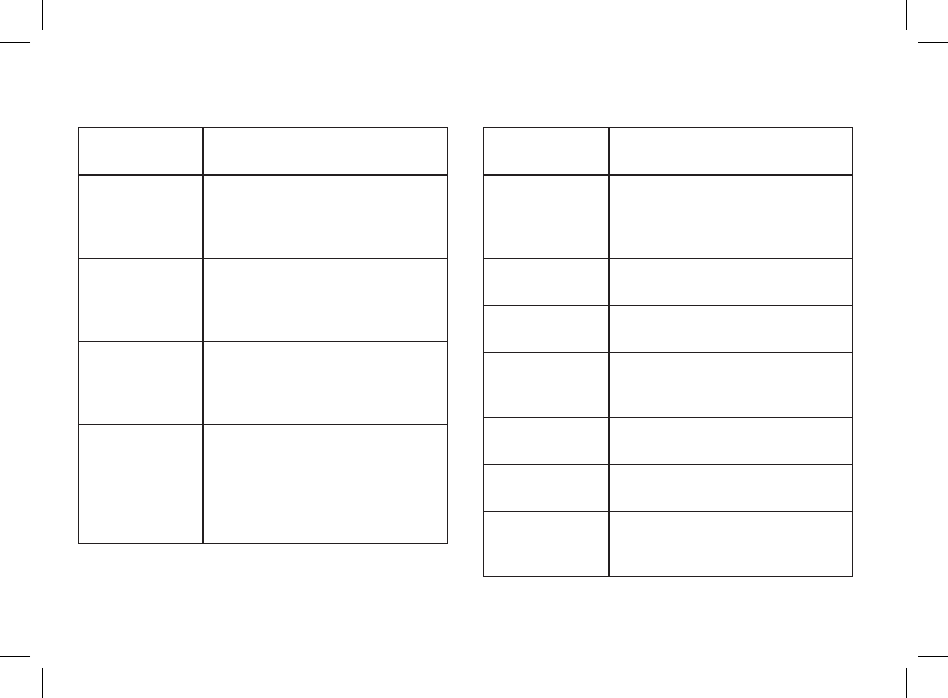
124
System
Message
Message Description
Please Enter
Special Code
You have inserted a SIM card that will
not work with your service provider’s
phone. Contact Customer Care if you
believe this is a valid SIM card.
Self Check Error
+ Number Code
A fault was detected with your
phone. If this error recurs, note the
error code and contact Customer
Care.
Self Check Fail
+ Number Code
An operational fault was detected
with your phone. Note the numeric
code, turn your phone off, and
contact Customer Care.
PIN Blocked
Call Your
provider
The incorrect PIN was entered 3
consecutive times. You will be unable
to place or receive calls on your
phone. Contact Customer Care to
have them obtain the PIN Unblock
Key (PUK) code.
System
Message
Message Description
Insert SIM Your SIM card is not being detected.
Please check to ensure that you have
inserted the SIM card correctly into
your phone.
Enter SIM PIN
Code
Please enter your 4- to 8- digit SIM
PIN code.
Enter Unlock
Code
Auto Phone Lock is activated. Enter
your unlock code.
New Browser
Message
Memory Full!
Warns of low memory for Net Alerts.
Scanning for
Satellites
Searching for GPS satellites.
Unable to
Locate Sats
Could not find GPS satellites.
Technical Error A problem occurred in your phone’s
GPS circuitry. If this error occurs,
contact Customer Care.

125
Wireless Phone Safety Tips
Your Motorola M710 telephone gives you the powerful
ability to communicate almost anywhere, anytime,
wherever wireless phone service is available and safety
conditions allow. But an important responsibility
accompanies the benefits of wireless phones, one that
every user must uphold while using them.
When driving a car, driving is your first responsibility. If you
find it necessary to use your M710 phone while behind
the wheel of a car, practice good common sense and
remember the following tips:
1 Get to know your Motorola M710 phone and its
features such as speed dial and redial. If available, these
features help you to place your call without taking your
attention off the road.
2 Let the person you are speaking with know you are
driving; if necessary, suspend the call in heavy traffic
or hazardous weather conditions. Rain, sleet, snow, ice,
and even heavy traffic can be hazardous.
3 If you receive an incoming call at an inconvenient time
do not take notes or look up phone numbers while
driving. Jotting down a “to do” list or going through
your address book takes attention away from your
primary responsibility - driving safely.
4 Dial sensibly and assess the traffic; if possible, place
calls when you are not moving or before pulling into
traffic. Try to plan calls when your car will be stationary.
If you need to make a call while moving, dial only a
few numbers, check the road and your mirrors, then
continue.
5 Do not engage in stressful or emotional conversations
that may distract your attention. Make people you
are talking with aware you are driving and suspend
conversations which have the potential to divert your
attention away from the road.
6 Use your M710 phone to call for help. Dial the
appropriate emergency number in the case of fire,
traffic accident or medical emergency.*
7 Use your M710 phone to help others in emergencies.
If you see an auto accident, crime in progress or other
serious emergency where lives are in danger, call the
emergency number, as you would want others to do
for you.*
* Wherever wireless phone service is available.

126
4 Call assistance services, like towing services, or non-
emergency assistance services. If you see a broken-
down vehicle posing no serious hazard, a broken
traffic signal, a minor traffic accident where no one
appears injured, or a vehicle you know to be stolen,
call assistance services that provide assistance in non-
emergency events.

127

128

Index
129

130

Index
131

132